Disease burden in Australia (indigenous and non-indigenous) 5 Comparison of the United States (indigenous and non-indigenous) 5 Disease burden in the University Name of the Author Name
VerifiedAdded on 2022/08/13
|22
|5639
|37
AI Summary
EPIDEMIOLOGY EPIDEMIOLOGY 20 COMPARE AND CONTRAST been Diabetes BURDEN Name of the Student Name of the University Author Note Part A 3 Introduction 3 Australian Health Priority Area 3 Literature analysis 4 Disease burden in Australia (indigenous and non-indigenous Australians) 5 Disease burden in the United States (indigenous and non-indigenous Australians) 5 Comparison of burden in both the countries 7 Conclusion 8 Part B 8 Introduction 8 Area of the highest prevalence 9 Strategy to reduce
Contribute Materials
Your contribution can guide someone’s learning journey. Share your
documents today.
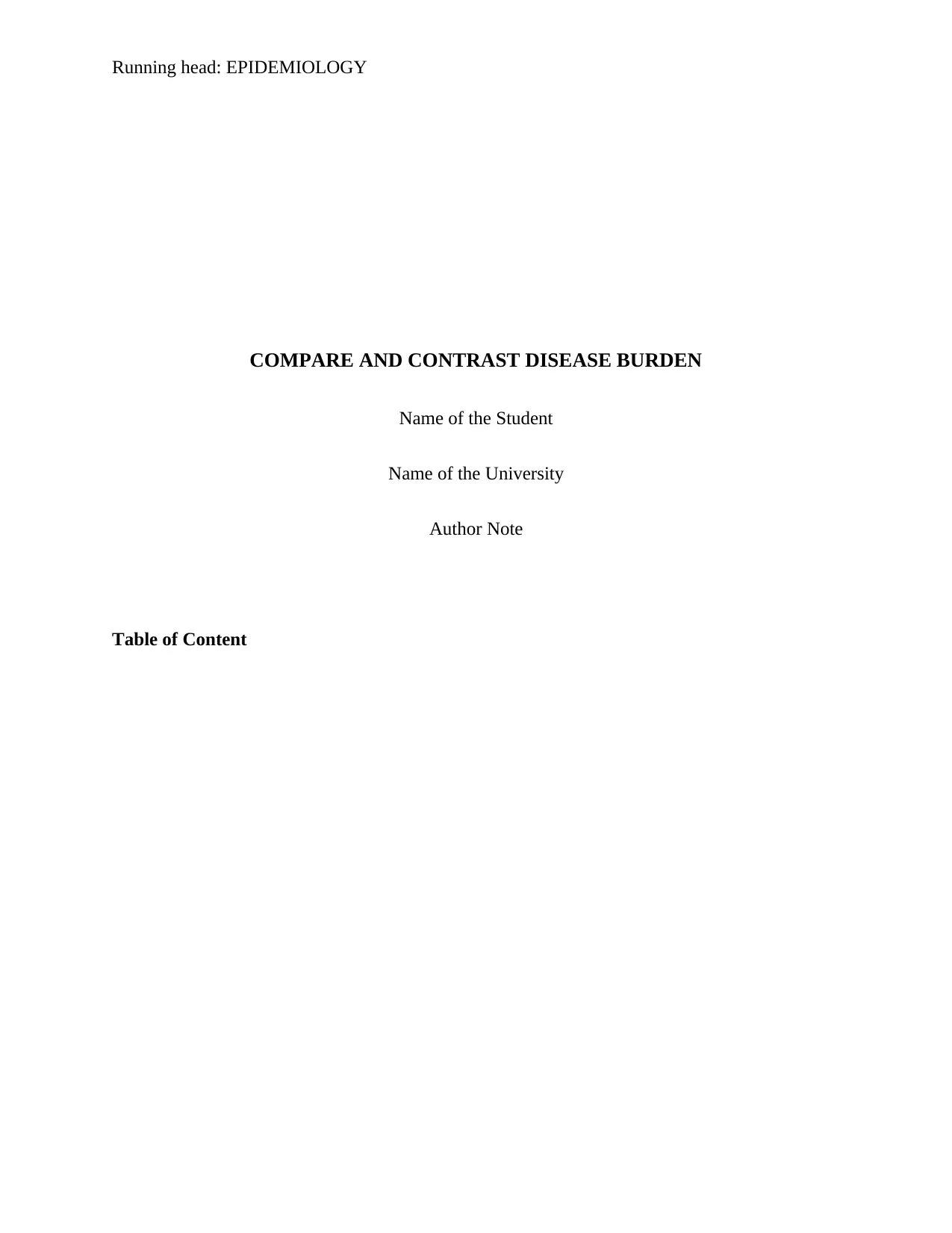
Running head: EPIDEMIOLOGY
COMPARE AND CONTRAST DISEASE BURDEN
Name of the Student
Name of the University
Author Note
Table of Content
COMPARE AND CONTRAST DISEASE BURDEN
Name of the Student
Name of the University
Author Note
Table of Content
Secure Best Marks with AI Grader
Need help grading? Try our AI Grader for instant feedback on your assignments.
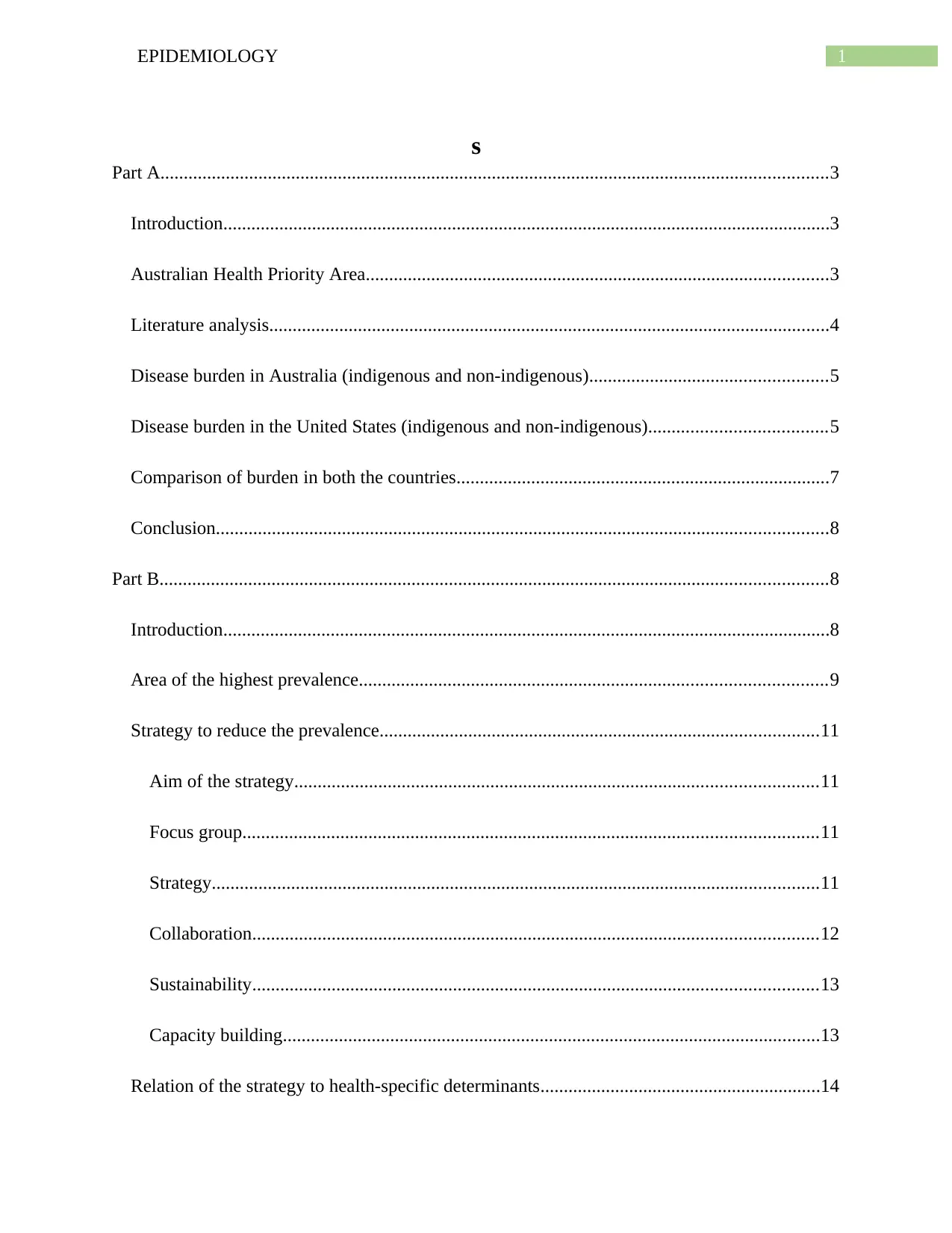
1EPIDEMIOLOGY
s
Part A...............................................................................................................................................3
Introduction..................................................................................................................................3
Australian Health Priority Area...................................................................................................3
Literature analysis........................................................................................................................4
Disease burden in Australia (indigenous and non-indigenous)...................................................5
Disease burden in the United States (indigenous and non-indigenous)......................................5
Comparison of burden in both the countries................................................................................7
Conclusion...................................................................................................................................8
Part B...............................................................................................................................................8
Introduction..................................................................................................................................8
Area of the highest prevalence....................................................................................................9
Strategy to reduce the prevalence..............................................................................................11
Aim of the strategy................................................................................................................11
Focus group...........................................................................................................................11
Strategy..................................................................................................................................11
Collaboration.........................................................................................................................12
Sustainability.........................................................................................................................13
Capacity building...................................................................................................................13
Relation of the strategy to health-specific determinants............................................................14
s
Part A...............................................................................................................................................3
Introduction..................................................................................................................................3
Australian Health Priority Area...................................................................................................3
Literature analysis........................................................................................................................4
Disease burden in Australia (indigenous and non-indigenous)...................................................5
Disease burden in the United States (indigenous and non-indigenous)......................................5
Comparison of burden in both the countries................................................................................7
Conclusion...................................................................................................................................8
Part B...............................................................................................................................................8
Introduction..................................................................................................................................8
Area of the highest prevalence....................................................................................................9
Strategy to reduce the prevalence..............................................................................................11
Aim of the strategy................................................................................................................11
Focus group...........................................................................................................................11
Strategy..................................................................................................................................11
Collaboration.........................................................................................................................12
Sustainability.........................................................................................................................13
Capacity building...................................................................................................................13
Relation of the strategy to health-specific determinants............................................................14

2EPIDEMIOLOGY
Conclusion.................................................................................................................................14
References......................................................................................................................................16
Conclusion.................................................................................................................................14
References......................................................................................................................................16
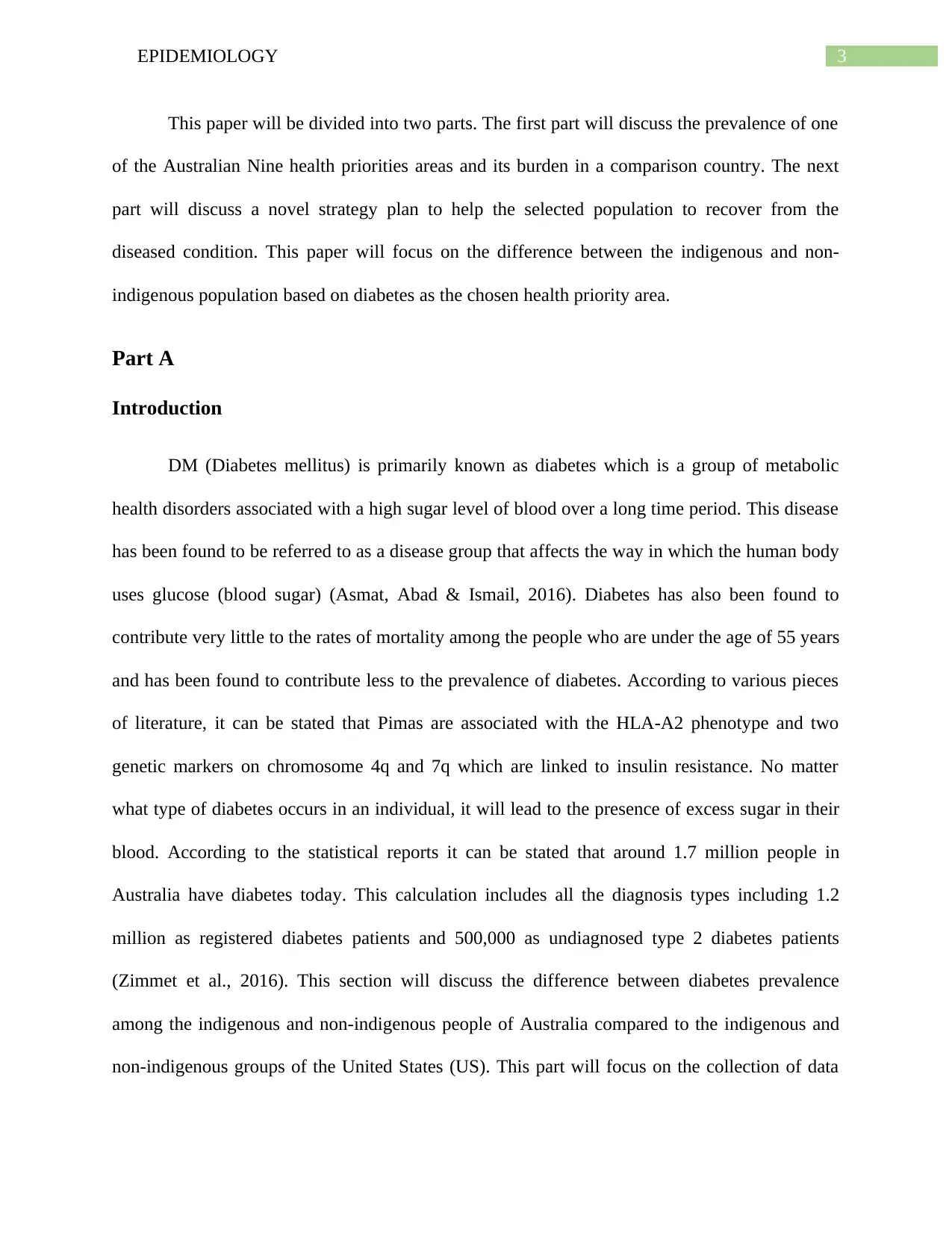
3EPIDEMIOLOGY
This paper will be divided into two parts. The first part will discuss the prevalence of one
of the Australian Nine health priorities areas and its burden in a comparison country. The next
part will discuss a novel strategy plan to help the selected population to recover from the
diseased condition. This paper will focus on the difference between the indigenous and non-
indigenous population based on diabetes as the chosen health priority area.
Part A
Introduction
DM (Diabetes mellitus) is primarily known as diabetes which is a group of metabolic
health disorders associated with a high sugar level of blood over a long time period. This disease
has been found to be referred to as a disease group that affects the way in which the human body
uses glucose (blood sugar) (Asmat, Abad & Ismail, 2016). Diabetes has also been found to
contribute very little to the rates of mortality among the people who are under the age of 55 years
and has been found to contribute less to the prevalence of diabetes. According to various pieces
of literature, it can be stated that Pimas are associated with the HLA-A2 phenotype and two
genetic markers on chromosome 4q and 7q which are linked to insulin resistance. No matter
what type of diabetes occurs in an individual, it will lead to the presence of excess sugar in their
blood. According to the statistical reports it can be stated that around 1.7 million people in
Australia have diabetes today. This calculation includes all the diagnosis types including 1.2
million as registered diabetes patients and 500,000 as undiagnosed type 2 diabetes patients
(Zimmet et al., 2016). This section will discuss the difference between diabetes prevalence
among the indigenous and non-indigenous people of Australia compared to the indigenous and
non-indigenous groups of the United States (US). This part will focus on the collection of data
This paper will be divided into two parts. The first part will discuss the prevalence of one
of the Australian Nine health priorities areas and its burden in a comparison country. The next
part will discuss a novel strategy plan to help the selected population to recover from the
diseased condition. This paper will focus on the difference between the indigenous and non-
indigenous population based on diabetes as the chosen health priority area.
Part A
Introduction
DM (Diabetes mellitus) is primarily known as diabetes which is a group of metabolic
health disorders associated with a high sugar level of blood over a long time period. This disease
has been found to be referred to as a disease group that affects the way in which the human body
uses glucose (blood sugar) (Asmat, Abad & Ismail, 2016). Diabetes has also been found to
contribute very little to the rates of mortality among the people who are under the age of 55 years
and has been found to contribute less to the prevalence of diabetes. According to various pieces
of literature, it can be stated that Pimas are associated with the HLA-A2 phenotype and two
genetic markers on chromosome 4q and 7q which are linked to insulin resistance. No matter
what type of diabetes occurs in an individual, it will lead to the presence of excess sugar in their
blood. According to the statistical reports it can be stated that around 1.7 million people in
Australia have diabetes today. This calculation includes all the diagnosis types including 1.2
million as registered diabetes patients and 500,000 as undiagnosed type 2 diabetes patients
(Zimmet et al., 2016). This section will discuss the difference between diabetes prevalence
among the indigenous and non-indigenous people of Australia compared to the indigenous and
non-indigenous groups of the United States (US). This part will focus on the collection of data
Secure Best Marks with AI Grader
Need help grading? Try our AI Grader for instant feedback on your assignments.
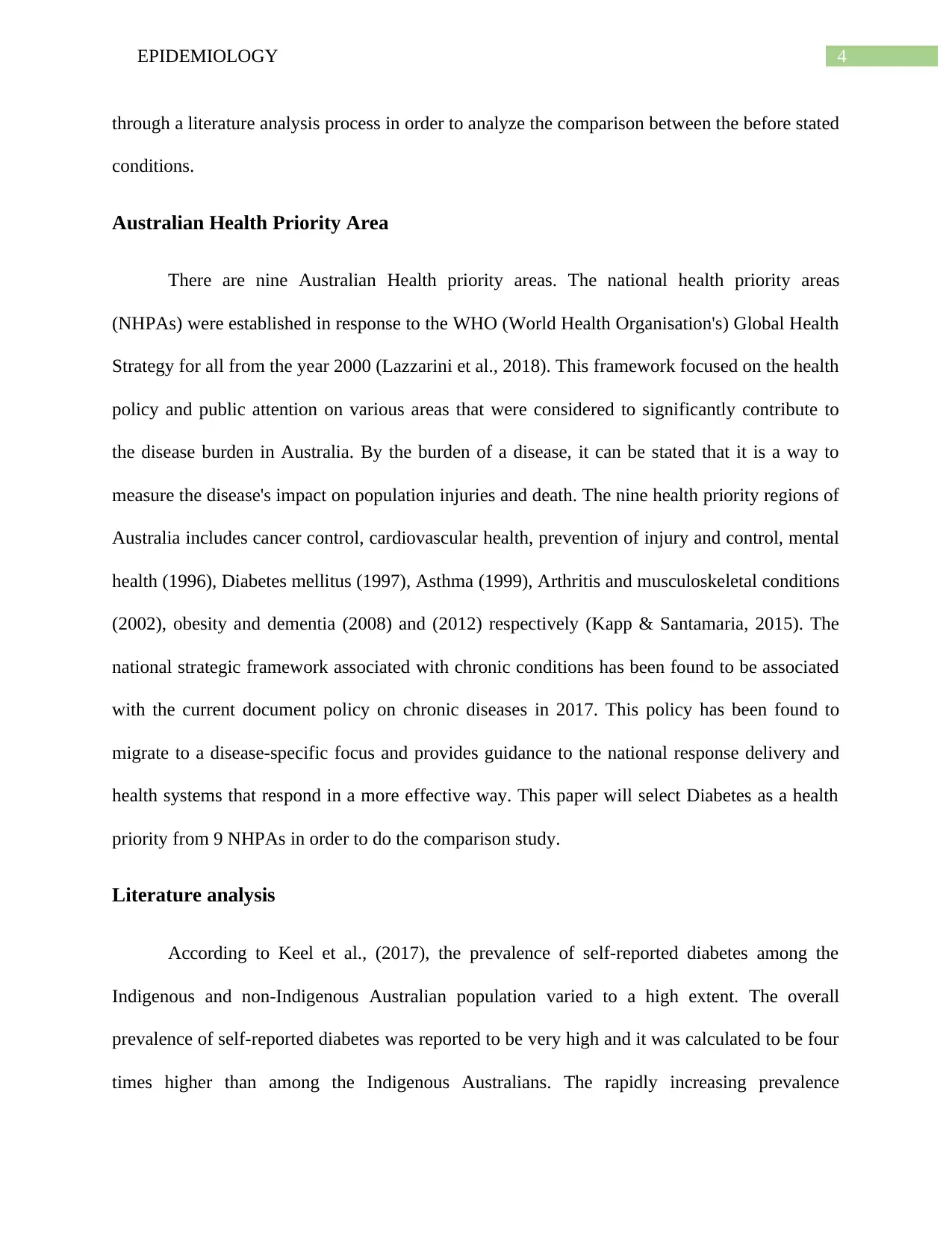
4EPIDEMIOLOGY
through a literature analysis process in order to analyze the comparison between the before stated
conditions.
Australian Health Priority Area
There are nine Australian Health priority areas. The national health priority areas
(NHPAs) were established in response to the WHO (World Health Organisation's) Global Health
Strategy for all from the year 2000 (Lazzarini et al., 2018). This framework focused on the health
policy and public attention on various areas that were considered to significantly contribute to
the disease burden in Australia. By the burden of a disease, it can be stated that it is a way to
measure the disease's impact on population injuries and death. The nine health priority regions of
Australia includes cancer control, cardiovascular health, prevention of injury and control, mental
health (1996), Diabetes mellitus (1997), Asthma (1999), Arthritis and musculoskeletal conditions
(2002), obesity and dementia (2008) and (2012) respectively (Kapp & Santamaria, 2015). The
national strategic framework associated with chronic conditions has been found to be associated
with the current document policy on chronic diseases in 2017. This policy has been found to
migrate to a disease-specific focus and provides guidance to the national response delivery and
health systems that respond in a more effective way. This paper will select Diabetes as a health
priority from 9 NHPAs in order to do the comparison study.
Literature analysis
According to Keel et al., (2017), the prevalence of self-reported diabetes among the
Indigenous and non-Indigenous Australian population varied to a high extent. The overall
prevalence of self-reported diabetes was reported to be very high and it was calculated to be four
times higher than among the Indigenous Australians. The rapidly increasing prevalence
through a literature analysis process in order to analyze the comparison between the before stated
conditions.
Australian Health Priority Area
There are nine Australian Health priority areas. The national health priority areas
(NHPAs) were established in response to the WHO (World Health Organisation's) Global Health
Strategy for all from the year 2000 (Lazzarini et al., 2018). This framework focused on the health
policy and public attention on various areas that were considered to significantly contribute to
the disease burden in Australia. By the burden of a disease, it can be stated that it is a way to
measure the disease's impact on population injuries and death. The nine health priority regions of
Australia includes cancer control, cardiovascular health, prevention of injury and control, mental
health (1996), Diabetes mellitus (1997), Asthma (1999), Arthritis and musculoskeletal conditions
(2002), obesity and dementia (2008) and (2012) respectively (Kapp & Santamaria, 2015). The
national strategic framework associated with chronic conditions has been found to be associated
with the current document policy on chronic diseases in 2017. This policy has been found to
migrate to a disease-specific focus and provides guidance to the national response delivery and
health systems that respond in a more effective way. This paper will select Diabetes as a health
priority from 9 NHPAs in order to do the comparison study.
Literature analysis
According to Keel et al., (2017), the prevalence of self-reported diabetes among the
Indigenous and non-Indigenous Australian population varied to a high extent. The overall
prevalence of self-reported diabetes was reported to be very high and it was calculated to be four
times higher than among the Indigenous Australians. The rapidly increasing prevalence
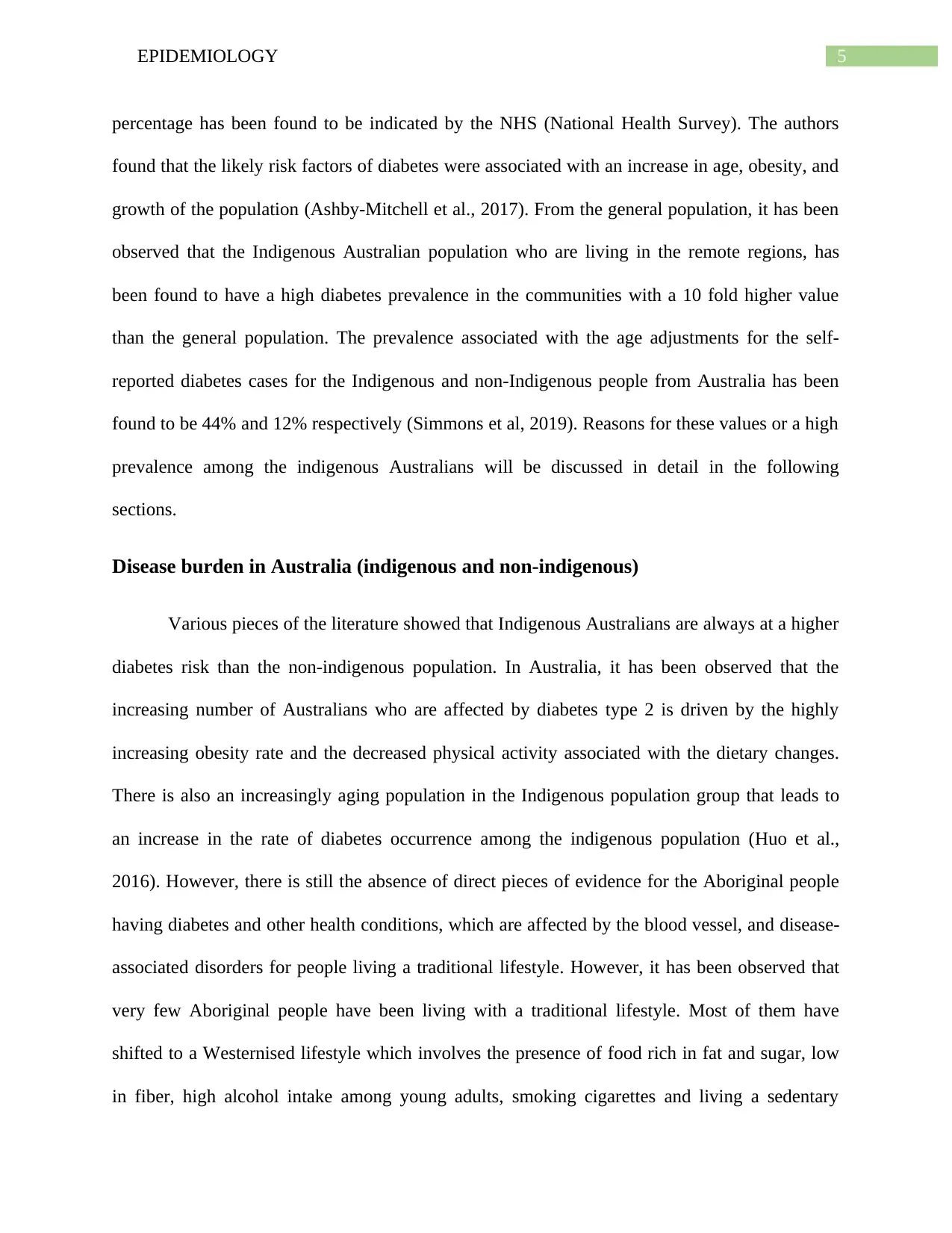
5EPIDEMIOLOGY
percentage has been found to be indicated by the NHS (National Health Survey). The authors
found that the likely risk factors of diabetes were associated with an increase in age, obesity, and
growth of the population (Ashby-Mitchell et al., 2017). From the general population, it has been
observed that the Indigenous Australian population who are living in the remote regions, has
been found to have a high diabetes prevalence in the communities with a 10 fold higher value
than the general population. The prevalence associated with the age adjustments for the self-
reported diabetes cases for the Indigenous and non-Indigenous people from Australia has been
found to be 44% and 12% respectively (Simmons et al, 2019). Reasons for these values or a high
prevalence among the indigenous Australians will be discussed in detail in the following
sections.
Disease burden in Australia (indigenous and non-indigenous)
Various pieces of the literature showed that Indigenous Australians are always at a higher
diabetes risk than the non-indigenous population. In Australia, it has been observed that the
increasing number of Australians who are affected by diabetes type 2 is driven by the highly
increasing obesity rate and the decreased physical activity associated with the dietary changes.
There is also an increasingly aging population in the Indigenous population group that leads to
an increase in the rate of diabetes occurrence among the indigenous population (Huo et al.,
2016). However, there is still the absence of direct pieces of evidence for the Aboriginal people
having diabetes and other health conditions, which are affected by the blood vessel, and disease-
associated disorders for people living a traditional lifestyle. However, it has been observed that
very few Aboriginal people have been living with a traditional lifestyle. Most of them have
shifted to a Westernised lifestyle which involves the presence of food rich in fat and sugar, low
in fiber, high alcohol intake among young adults, smoking cigarettes and living a sedentary
percentage has been found to be indicated by the NHS (National Health Survey). The authors
found that the likely risk factors of diabetes were associated with an increase in age, obesity, and
growth of the population (Ashby-Mitchell et al., 2017). From the general population, it has been
observed that the Indigenous Australian population who are living in the remote regions, has
been found to have a high diabetes prevalence in the communities with a 10 fold higher value
than the general population. The prevalence associated with the age adjustments for the self-
reported diabetes cases for the Indigenous and non-Indigenous people from Australia has been
found to be 44% and 12% respectively (Simmons et al, 2019). Reasons for these values or a high
prevalence among the indigenous Australians will be discussed in detail in the following
sections.
Disease burden in Australia (indigenous and non-indigenous)
Various pieces of the literature showed that Indigenous Australians are always at a higher
diabetes risk than the non-indigenous population. In Australia, it has been observed that the
increasing number of Australians who are affected by diabetes type 2 is driven by the highly
increasing obesity rate and the decreased physical activity associated with the dietary changes.
There is also an increasingly aging population in the Indigenous population group that leads to
an increase in the rate of diabetes occurrence among the indigenous population (Huo et al.,
2016). However, there is still the absence of direct pieces of evidence for the Aboriginal people
having diabetes and other health conditions, which are affected by the blood vessel, and disease-
associated disorders for people living a traditional lifestyle. However, it has been observed that
very few Aboriginal people have been living with a traditional lifestyle. Most of them have
shifted to a Westernised lifestyle which involves the presence of food rich in fat and sugar, low
in fiber, high alcohol intake among young adults, smoking cigarettes and living a sedentary
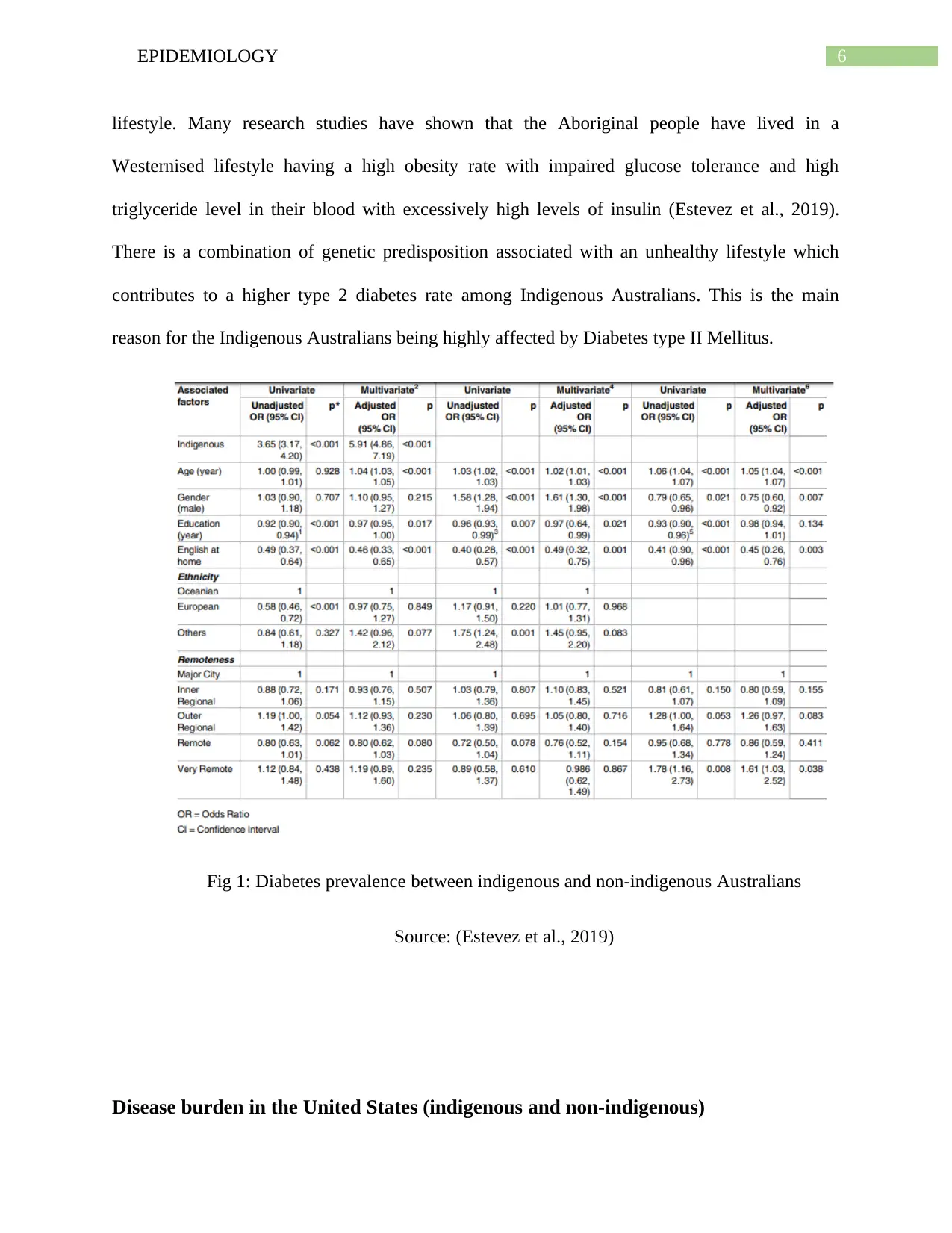
6EPIDEMIOLOGY
lifestyle. Many research studies have shown that the Aboriginal people have lived in a
Westernised lifestyle having a high obesity rate with impaired glucose tolerance and high
triglyceride level in their blood with excessively high levels of insulin (Estevez et al., 2019).
There is a combination of genetic predisposition associated with an unhealthy lifestyle which
contributes to a higher type 2 diabetes rate among Indigenous Australians. This is the main
reason for the Indigenous Australians being highly affected by Diabetes type II Mellitus.
Fig 1: Diabetes prevalence between indigenous and non-indigenous Australians
Source: (Estevez et al., 2019)
Disease burden in the United States (indigenous and non-indigenous)
lifestyle. Many research studies have shown that the Aboriginal people have lived in a
Westernised lifestyle having a high obesity rate with impaired glucose tolerance and high
triglyceride level in their blood with excessively high levels of insulin (Estevez et al., 2019).
There is a combination of genetic predisposition associated with an unhealthy lifestyle which
contributes to a higher type 2 diabetes rate among Indigenous Australians. This is the main
reason for the Indigenous Australians being highly affected by Diabetes type II Mellitus.
Fig 1: Diabetes prevalence between indigenous and non-indigenous Australians
Source: (Estevez et al., 2019)
Disease burden in the United States (indigenous and non-indigenous)
Paraphrase This Document
Need a fresh take? Get an instant paraphrase of this document with our AI Paraphraser
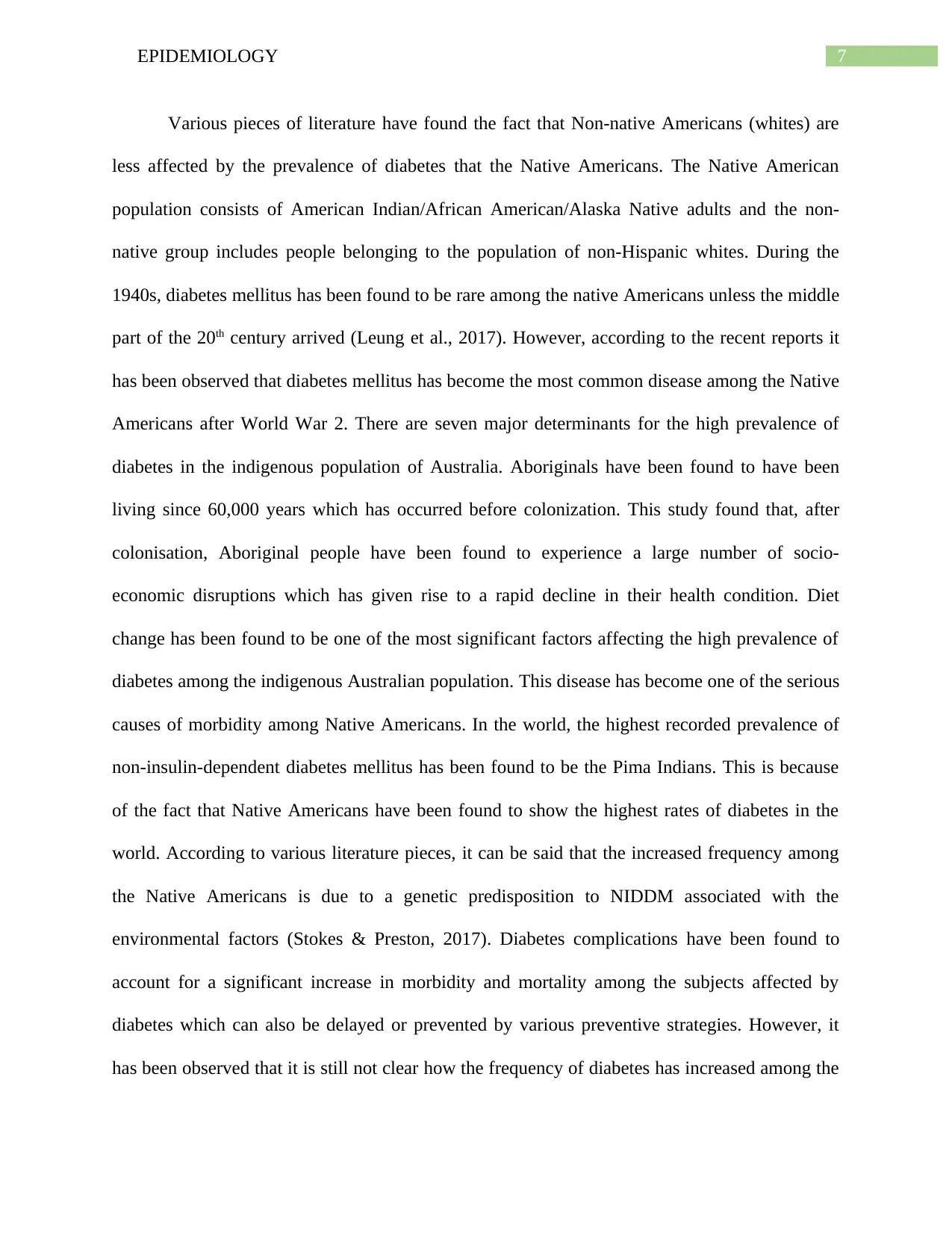
7EPIDEMIOLOGY
Various pieces of literature have found the fact that Non-native Americans (whites) are
less affected by the prevalence of diabetes that the Native Americans. The Native American
population consists of American Indian/African American/Alaska Native adults and the non-
native group includes people belonging to the population of non-Hispanic whites. During the
1940s, diabetes mellitus has been found to be rare among the native Americans unless the middle
part of the 20th century arrived (Leung et al., 2017). However, according to the recent reports it
has been observed that diabetes mellitus has become the most common disease among the Native
Americans after World War 2. There are seven major determinants for the high prevalence of
diabetes in the indigenous population of Australia. Aboriginals have been found to have been
living since 60,000 years which has occurred before colonization. This study found that, after
colonisation, Aboriginal people have been found to experience a large number of socio-
economic disruptions which has given rise to a rapid decline in their health condition. Diet
change has been found to be one of the most significant factors affecting the high prevalence of
diabetes among the indigenous Australian population. This disease has become one of the serious
causes of morbidity among Native Americans. In the world, the highest recorded prevalence of
non-insulin-dependent diabetes mellitus has been found to be the Pima Indians. This is because
of the fact that Native Americans have been found to show the highest rates of diabetes in the
world. According to various literature pieces, it can be said that the increased frequency among
the Native Americans is due to a genetic predisposition to NIDDM associated with the
environmental factors (Stokes & Preston, 2017). Diabetes complications have been found to
account for a significant increase in morbidity and mortality among the subjects affected by
diabetes which can also be delayed or prevented by various preventive strategies. However, it
has been observed that it is still not clear how the frequency of diabetes has increased among the
Various pieces of literature have found the fact that Non-native Americans (whites) are
less affected by the prevalence of diabetes that the Native Americans. The Native American
population consists of American Indian/African American/Alaska Native adults and the non-
native group includes people belonging to the population of non-Hispanic whites. During the
1940s, diabetes mellitus has been found to be rare among the native Americans unless the middle
part of the 20th century arrived (Leung et al., 2017). However, according to the recent reports it
has been observed that diabetes mellitus has become the most common disease among the Native
Americans after World War 2. There are seven major determinants for the high prevalence of
diabetes in the indigenous population of Australia. Aboriginals have been found to have been
living since 60,000 years which has occurred before colonization. This study found that, after
colonisation, Aboriginal people have been found to experience a large number of socio-
economic disruptions which has given rise to a rapid decline in their health condition. Diet
change has been found to be one of the most significant factors affecting the high prevalence of
diabetes among the indigenous Australian population. This disease has become one of the serious
causes of morbidity among Native Americans. In the world, the highest recorded prevalence of
non-insulin-dependent diabetes mellitus has been found to be the Pima Indians. This is because
of the fact that Native Americans have been found to show the highest rates of diabetes in the
world. According to various literature pieces, it can be said that the increased frequency among
the Native Americans is due to a genetic predisposition to NIDDM associated with the
environmental factors (Stokes & Preston, 2017). Diabetes complications have been found to
account for a significant increase in morbidity and mortality among the subjects affected by
diabetes which can also be delayed or prevented by various preventive strategies. However, it
has been observed that it is still not clear how the frequency of diabetes has increased among the
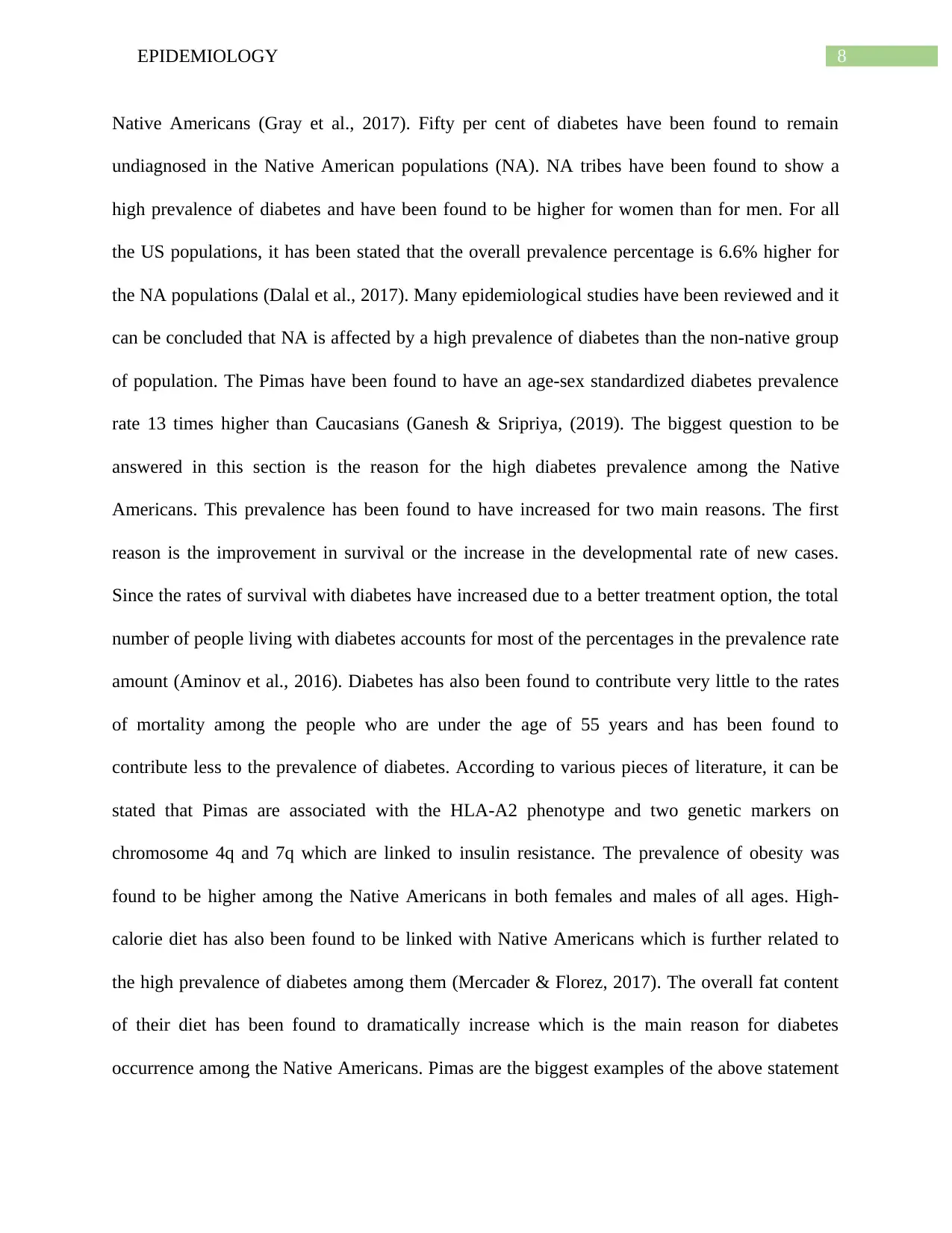
8EPIDEMIOLOGY
Native Americans (Gray et al., 2017). Fifty per cent of diabetes have been found to remain
undiagnosed in the Native American populations (NA). NA tribes have been found to show a
high prevalence of diabetes and have been found to be higher for women than for men. For all
the US populations, it has been stated that the overall prevalence percentage is 6.6% higher for
the NA populations (Dalal et al., 2017). Many epidemiological studies have been reviewed and it
can be concluded that NA is affected by a high prevalence of diabetes than the non-native group
of population. The Pimas have been found to have an age-sex standardized diabetes prevalence
rate 13 times higher than Caucasians (Ganesh & Sripriya, (2019). The biggest question to be
answered in this section is the reason for the high diabetes prevalence among the Native
Americans. This prevalence has been found to have increased for two main reasons. The first
reason is the improvement in survival or the increase in the developmental rate of new cases.
Since the rates of survival with diabetes have increased due to a better treatment option, the total
number of people living with diabetes accounts for most of the percentages in the prevalence rate
amount (Aminov et al., 2016). Diabetes has also been found to contribute very little to the rates
of mortality among the people who are under the age of 55 years and has been found to
contribute less to the prevalence of diabetes. According to various pieces of literature, it can be
stated that Pimas are associated with the HLA-A2 phenotype and two genetic markers on
chromosome 4q and 7q which are linked to insulin resistance. The prevalence of obesity was
found to be higher among the Native Americans in both females and males of all ages. High-
calorie diet has also been found to be linked with Native Americans which is further related to
the high prevalence of diabetes among them (Mercader & Florez, 2017). The overall fat content
of their diet has been found to dramatically increase which is the main reason for diabetes
occurrence among the Native Americans. Pimas are the biggest examples of the above statement
Native Americans (Gray et al., 2017). Fifty per cent of diabetes have been found to remain
undiagnosed in the Native American populations (NA). NA tribes have been found to show a
high prevalence of diabetes and have been found to be higher for women than for men. For all
the US populations, it has been stated that the overall prevalence percentage is 6.6% higher for
the NA populations (Dalal et al., 2017). Many epidemiological studies have been reviewed and it
can be concluded that NA is affected by a high prevalence of diabetes than the non-native group
of population. The Pimas have been found to have an age-sex standardized diabetes prevalence
rate 13 times higher than Caucasians (Ganesh & Sripriya, (2019). The biggest question to be
answered in this section is the reason for the high diabetes prevalence among the Native
Americans. This prevalence has been found to have increased for two main reasons. The first
reason is the improvement in survival or the increase in the developmental rate of new cases.
Since the rates of survival with diabetes have increased due to a better treatment option, the total
number of people living with diabetes accounts for most of the percentages in the prevalence rate
amount (Aminov et al., 2016). Diabetes has also been found to contribute very little to the rates
of mortality among the people who are under the age of 55 years and has been found to
contribute less to the prevalence of diabetes. According to various pieces of literature, it can be
stated that Pimas are associated with the HLA-A2 phenotype and two genetic markers on
chromosome 4q and 7q which are linked to insulin resistance. The prevalence of obesity was
found to be higher among the Native Americans in both females and males of all ages. High-
calorie diet has also been found to be linked with Native Americans which is further related to
the high prevalence of diabetes among them (Mercader & Florez, 2017). The overall fat content
of their diet has been found to dramatically increase which is the main reason for diabetes
occurrence among the Native Americans. Pimas are the biggest examples of the above statement
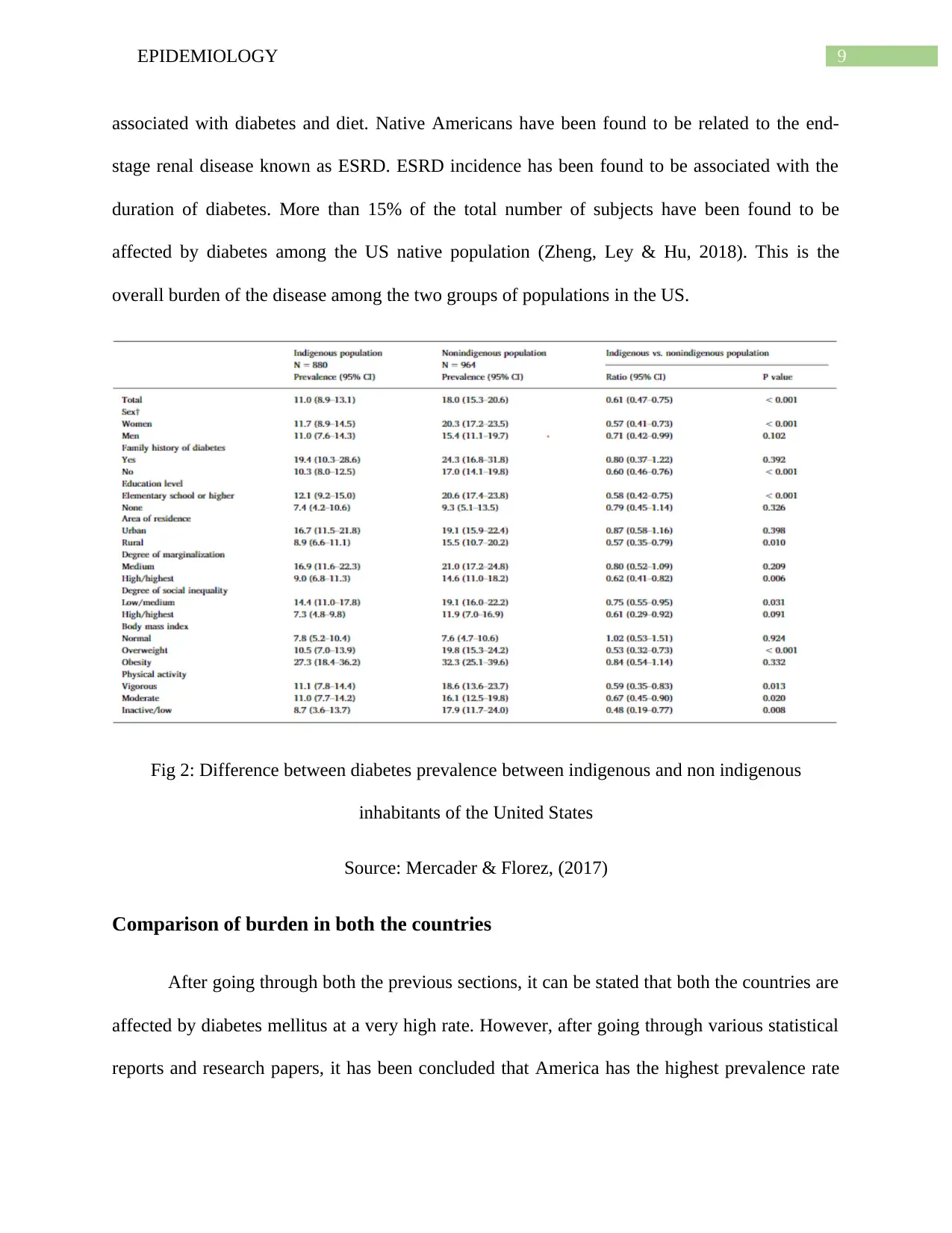
9EPIDEMIOLOGY
associated with diabetes and diet. Native Americans have been found to be related to the end-
stage renal disease known as ESRD. ESRD incidence has been found to be associated with the
duration of diabetes. More than 15% of the total number of subjects have been found to be
affected by diabetes among the US native population (Zheng, Ley & Hu, 2018). This is the
overall burden of the disease among the two groups of populations in the US.
Fig 2: Difference between diabetes prevalence between indigenous and non indigenous
inhabitants of the United States
Source: Mercader & Florez, (2017)
Comparison of burden in both the countries
After going through both the previous sections, it can be stated that both the countries are
affected by diabetes mellitus at a very high rate. However, after going through various statistical
reports and research papers, it has been concluded that America has the highest prevalence rate
associated with diabetes and diet. Native Americans have been found to be related to the end-
stage renal disease known as ESRD. ESRD incidence has been found to be associated with the
duration of diabetes. More than 15% of the total number of subjects have been found to be
affected by diabetes among the US native population (Zheng, Ley & Hu, 2018). This is the
overall burden of the disease among the two groups of populations in the US.
Fig 2: Difference between diabetes prevalence between indigenous and non indigenous
inhabitants of the United States
Source: Mercader & Florez, (2017)
Comparison of burden in both the countries
After going through both the previous sections, it can be stated that both the countries are
affected by diabetes mellitus at a very high rate. However, after going through various statistical
reports and research papers, it has been concluded that America has the highest prevalence rate
Secure Best Marks with AI Grader
Need help grading? Try our AI Grader for instant feedback on your assignments.
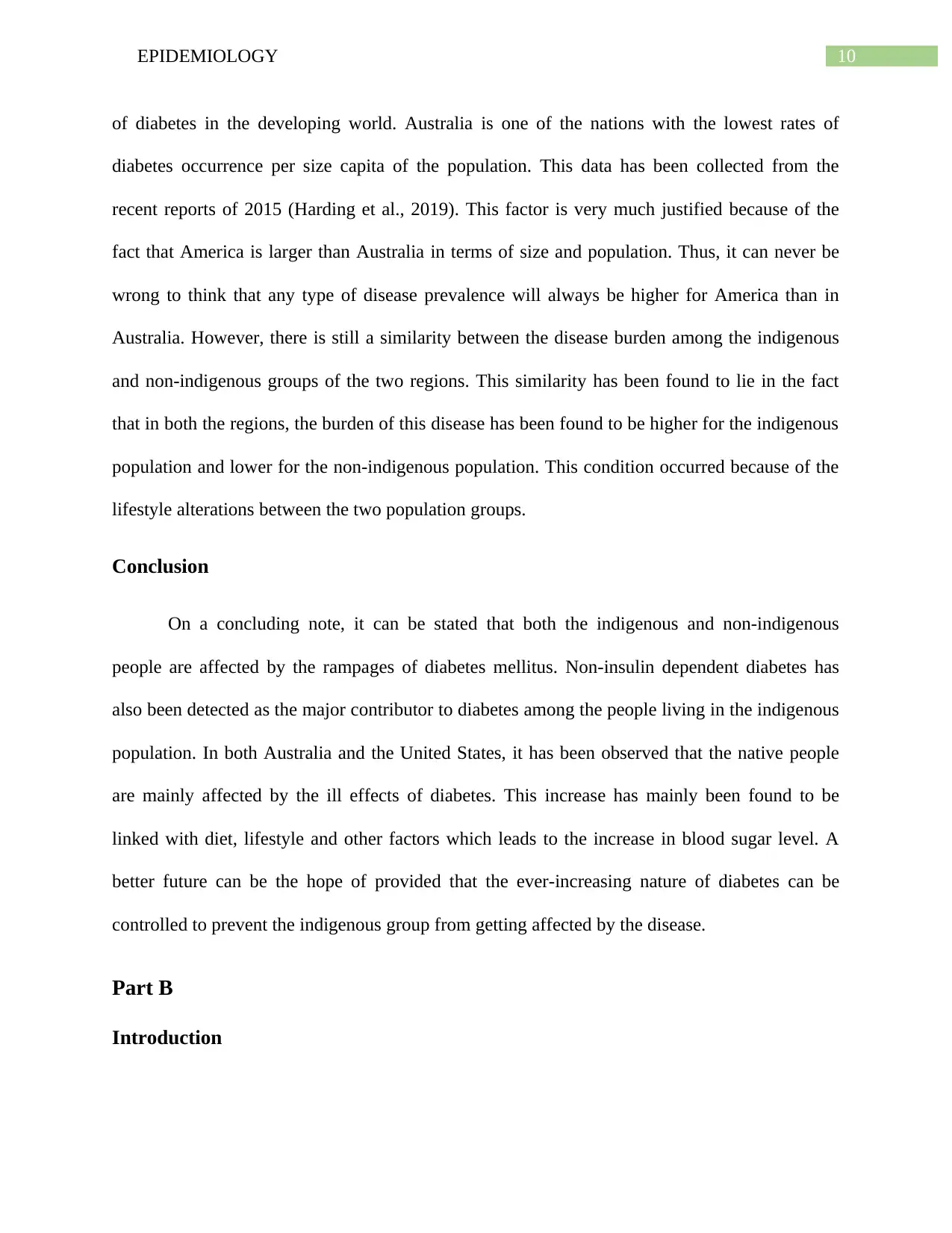
10EPIDEMIOLOGY
of diabetes in the developing world. Australia is one of the nations with the lowest rates of
diabetes occurrence per size capita of the population. This data has been collected from the
recent reports of 2015 (Harding et al., 2019). This factor is very much justified because of the
fact that America is larger than Australia in terms of size and population. Thus, it can never be
wrong to think that any type of disease prevalence will always be higher for America than in
Australia. However, there is still a similarity between the disease burden among the indigenous
and non-indigenous groups of the two regions. This similarity has been found to lie in the fact
that in both the regions, the burden of this disease has been found to be higher for the indigenous
population and lower for the non-indigenous population. This condition occurred because of the
lifestyle alterations between the two population groups.
Conclusion
On a concluding note, it can be stated that both the indigenous and non-indigenous
people are affected by the rampages of diabetes mellitus. Non-insulin dependent diabetes has
also been detected as the major contributor to diabetes among the people living in the indigenous
population. In both Australia and the United States, it has been observed that the native people
are mainly affected by the ill effects of diabetes. This increase has mainly been found to be
linked with diet, lifestyle and other factors which leads to the increase in blood sugar level. A
better future can be the hope of provided that the ever-increasing nature of diabetes can be
controlled to prevent the indigenous group from getting affected by the disease.
Part B
Introduction
of diabetes in the developing world. Australia is one of the nations with the lowest rates of
diabetes occurrence per size capita of the population. This data has been collected from the
recent reports of 2015 (Harding et al., 2019). This factor is very much justified because of the
fact that America is larger than Australia in terms of size and population. Thus, it can never be
wrong to think that any type of disease prevalence will always be higher for America than in
Australia. However, there is still a similarity between the disease burden among the indigenous
and non-indigenous groups of the two regions. This similarity has been found to lie in the fact
that in both the regions, the burden of this disease has been found to be higher for the indigenous
population and lower for the non-indigenous population. This condition occurred because of the
lifestyle alterations between the two population groups.
Conclusion
On a concluding note, it can be stated that both the indigenous and non-indigenous
people are affected by the rampages of diabetes mellitus. Non-insulin dependent diabetes has
also been detected as the major contributor to diabetes among the people living in the indigenous
population. In both Australia and the United States, it has been observed that the native people
are mainly affected by the ill effects of diabetes. This increase has mainly been found to be
linked with diet, lifestyle and other factors which leads to the increase in blood sugar level. A
better future can be the hope of provided that the ever-increasing nature of diabetes can be
controlled to prevent the indigenous group from getting affected by the disease.
Part B
Introduction
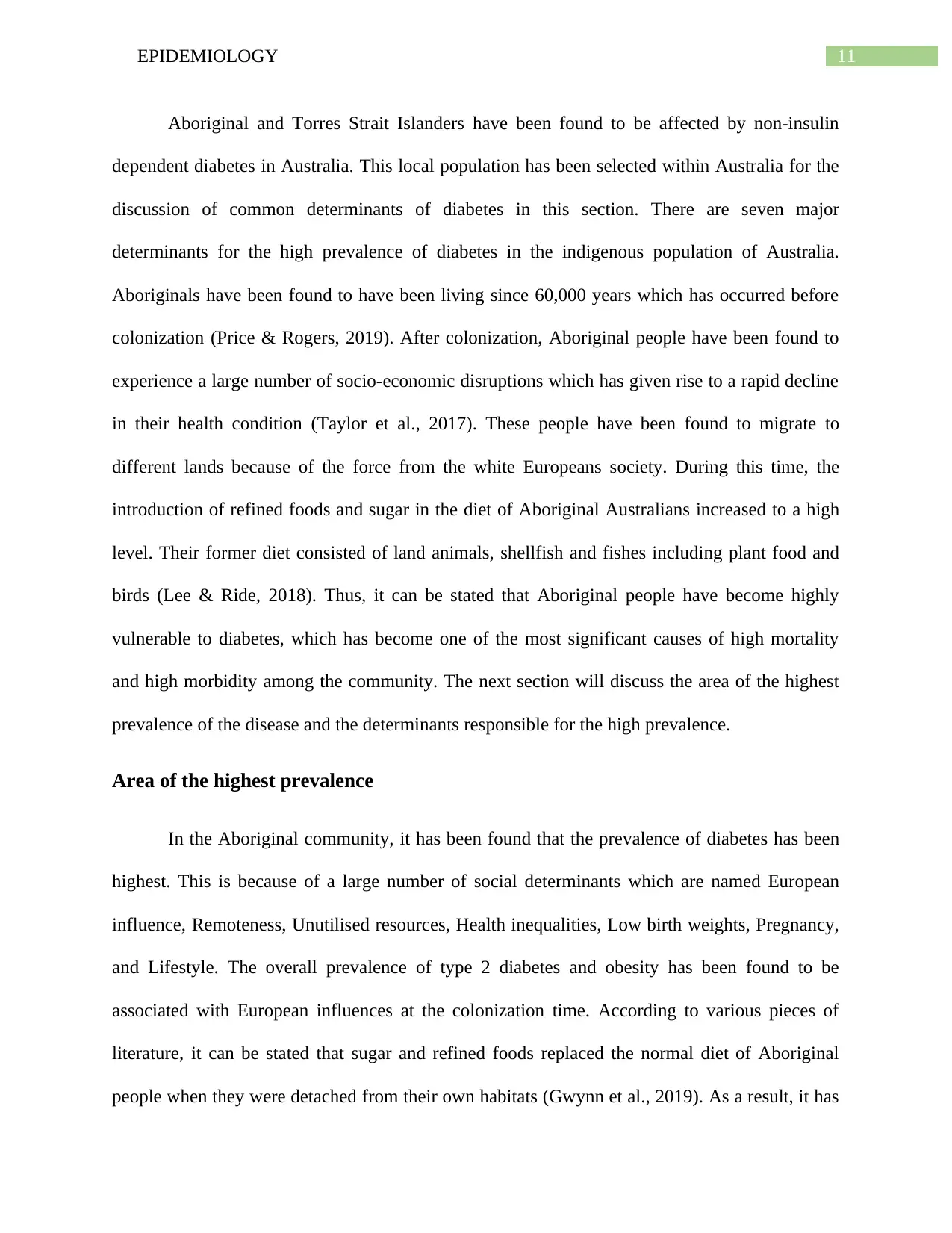
11EPIDEMIOLOGY
Aboriginal and Torres Strait Islanders have been found to be affected by non-insulin
dependent diabetes in Australia. This local population has been selected within Australia for the
discussion of common determinants of diabetes in this section. There are seven major
determinants for the high prevalence of diabetes in the indigenous population of Australia.
Aboriginals have been found to have been living since 60,000 years which has occurred before
colonization (Price & Rogers, 2019). After colonization, Aboriginal people have been found to
experience a large number of socio-economic disruptions which has given rise to a rapid decline
in their health condition (Taylor et al., 2017). These people have been found to migrate to
different lands because of the force from the white Europeans society. During this time, the
introduction of refined foods and sugar in the diet of Aboriginal Australians increased to a high
level. Their former diet consisted of land animals, shellfish and fishes including plant food and
birds (Lee & Ride, 2018). Thus, it can be stated that Aboriginal people have become highly
vulnerable to diabetes, which has become one of the most significant causes of high mortality
and high morbidity among the community. The next section will discuss the area of the highest
prevalence of the disease and the determinants responsible for the high prevalence.
Area of the highest prevalence
In the Aboriginal community, it has been found that the prevalence of diabetes has been
highest. This is because of a large number of social determinants which are named European
influence, Remoteness, Unutilised resources, Health inequalities, Low birth weights, Pregnancy,
and Lifestyle. The overall prevalence of type 2 diabetes and obesity has been found to be
associated with European influences at the colonization time. According to various pieces of
literature, it can be stated that sugar and refined foods replaced the normal diet of Aboriginal
people when they were detached from their own habitats (Gwynn et al., 2019). As a result, it has
Aboriginal and Torres Strait Islanders have been found to be affected by non-insulin
dependent diabetes in Australia. This local population has been selected within Australia for the
discussion of common determinants of diabetes in this section. There are seven major
determinants for the high prevalence of diabetes in the indigenous population of Australia.
Aboriginals have been found to have been living since 60,000 years which has occurred before
colonization (Price & Rogers, 2019). After colonization, Aboriginal people have been found to
experience a large number of socio-economic disruptions which has given rise to a rapid decline
in their health condition (Taylor et al., 2017). These people have been found to migrate to
different lands because of the force from the white Europeans society. During this time, the
introduction of refined foods and sugar in the diet of Aboriginal Australians increased to a high
level. Their former diet consisted of land animals, shellfish and fishes including plant food and
birds (Lee & Ride, 2018). Thus, it can be stated that Aboriginal people have become highly
vulnerable to diabetes, which has become one of the most significant causes of high mortality
and high morbidity among the community. The next section will discuss the area of the highest
prevalence of the disease and the determinants responsible for the high prevalence.
Area of the highest prevalence
In the Aboriginal community, it has been found that the prevalence of diabetes has been
highest. This is because of a large number of social determinants which are named European
influence, Remoteness, Unutilised resources, Health inequalities, Low birth weights, Pregnancy,
and Lifestyle. The overall prevalence of type 2 diabetes and obesity has been found to be
associated with European influences at the colonization time. According to various pieces of
literature, it can be stated that sugar and refined foods replaced the normal diet of Aboriginal
people when they were detached from their own habitats (Gwynn et al., 2019). As a result, it has
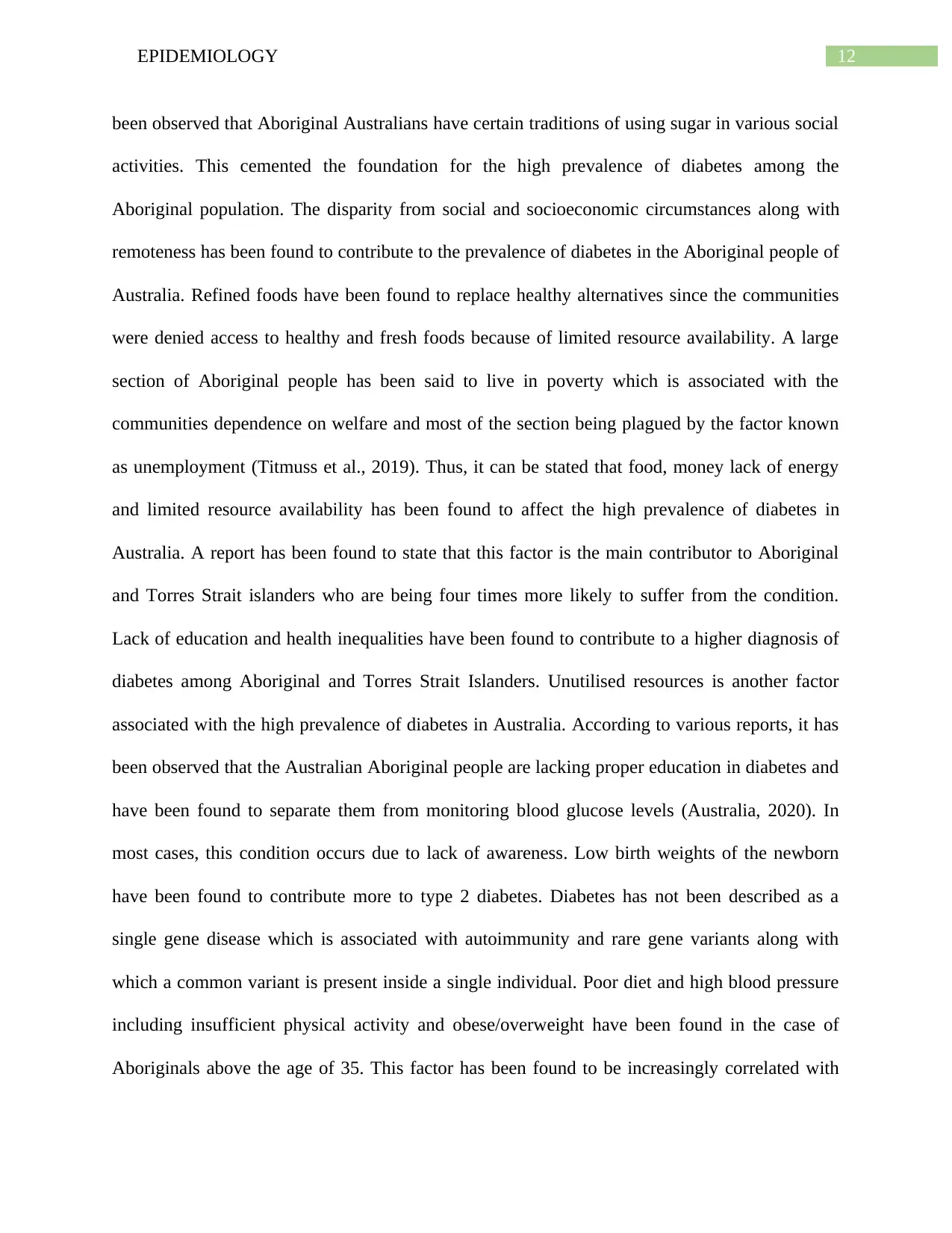
12EPIDEMIOLOGY
been observed that Aboriginal Australians have certain traditions of using sugar in various social
activities. This cemented the foundation for the high prevalence of diabetes among the
Aboriginal population. The disparity from social and socioeconomic circumstances along with
remoteness has been found to contribute to the prevalence of diabetes in the Aboriginal people of
Australia. Refined foods have been found to replace healthy alternatives since the communities
were denied access to healthy and fresh foods because of limited resource availability. A large
section of Aboriginal people has been said to live in poverty which is associated with the
communities dependence on welfare and most of the section being plagued by the factor known
as unemployment (Titmuss et al., 2019). Thus, it can be stated that food, money lack of energy
and limited resource availability has been found to affect the high prevalence of diabetes in
Australia. A report has been found to state that this factor is the main contributor to Aboriginal
and Torres Strait islanders who are being four times more likely to suffer from the condition.
Lack of education and health inequalities have been found to contribute to a higher diagnosis of
diabetes among Aboriginal and Torres Strait Islanders. Unutilised resources is another factor
associated with the high prevalence of diabetes in Australia. According to various reports, it has
been observed that the Australian Aboriginal people are lacking proper education in diabetes and
have been found to separate them from monitoring blood glucose levels (Australia, 2020). In
most cases, this condition occurs due to lack of awareness. Low birth weights of the newborn
have been found to contribute more to type 2 diabetes. Diabetes has not been described as a
single gene disease which is associated with autoimmunity and rare gene variants along with
which a common variant is present inside a single individual. Poor diet and high blood pressure
including insufficient physical activity and obese/overweight have been found in the case of
Aboriginals above the age of 35. This factor has been found to be increasingly correlated with
been observed that Aboriginal Australians have certain traditions of using sugar in various social
activities. This cemented the foundation for the high prevalence of diabetes among the
Aboriginal population. The disparity from social and socioeconomic circumstances along with
remoteness has been found to contribute to the prevalence of diabetes in the Aboriginal people of
Australia. Refined foods have been found to replace healthy alternatives since the communities
were denied access to healthy and fresh foods because of limited resource availability. A large
section of Aboriginal people has been said to live in poverty which is associated with the
communities dependence on welfare and most of the section being plagued by the factor known
as unemployment (Titmuss et al., 2019). Thus, it can be stated that food, money lack of energy
and limited resource availability has been found to affect the high prevalence of diabetes in
Australia. A report has been found to state that this factor is the main contributor to Aboriginal
and Torres Strait islanders who are being four times more likely to suffer from the condition.
Lack of education and health inequalities have been found to contribute to a higher diagnosis of
diabetes among Aboriginal and Torres Strait Islanders. Unutilised resources is another factor
associated with the high prevalence of diabetes in Australia. According to various reports, it has
been observed that the Australian Aboriginal people are lacking proper education in diabetes and
have been found to separate them from monitoring blood glucose levels (Australia, 2020). In
most cases, this condition occurs due to lack of awareness. Low birth weights of the newborn
have been found to contribute more to type 2 diabetes. Diabetes has not been described as a
single gene disease which is associated with autoimmunity and rare gene variants along with
which a common variant is present inside a single individual. Poor diet and high blood pressure
including insufficient physical activity and obese/overweight have been found in the case of
Aboriginals above the age of 35. This factor has been found to be increasingly correlated with
Paraphrase This Document
Need a fresh take? Get an instant paraphrase of this document with our AI Paraphraser
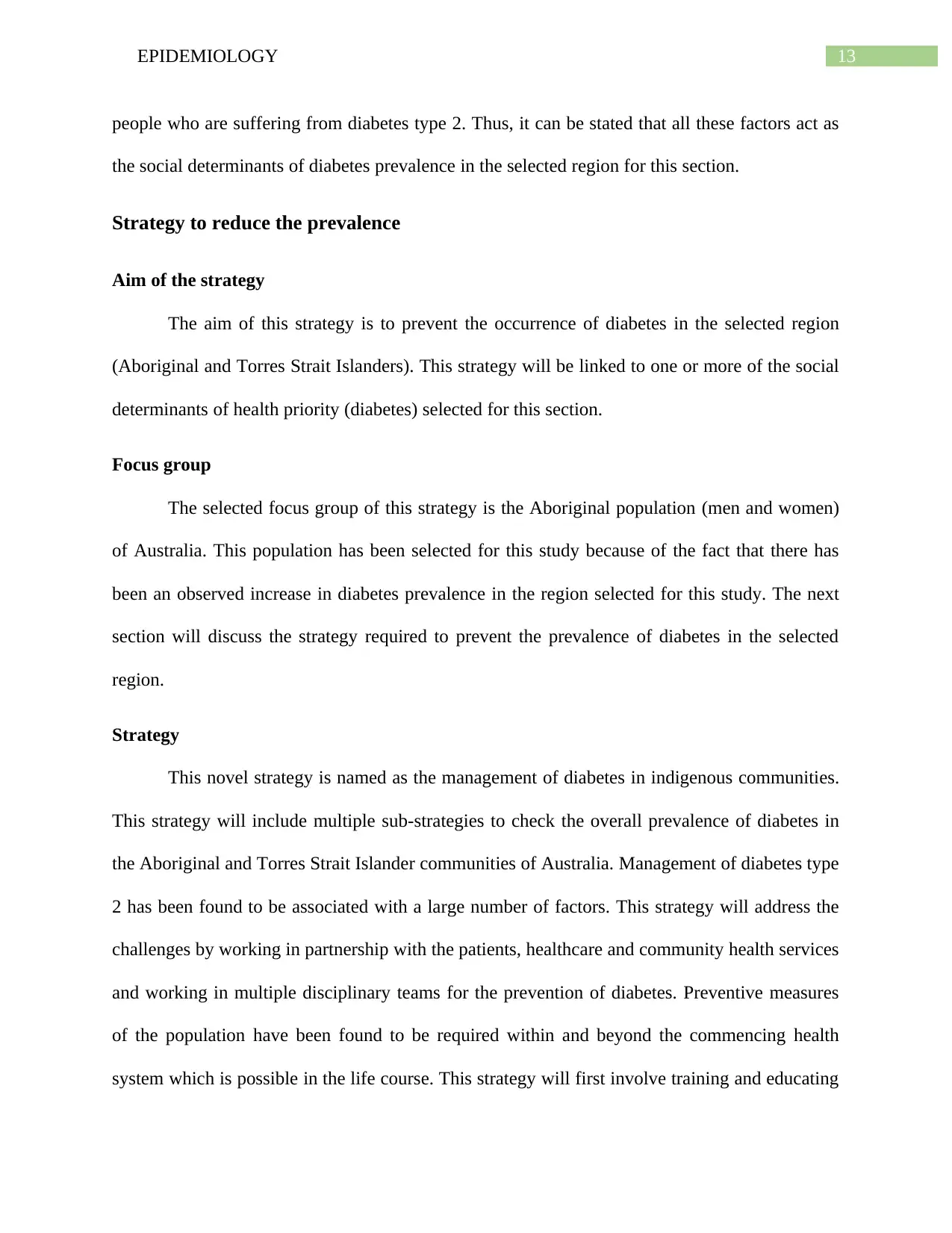
13EPIDEMIOLOGY
people who are suffering from diabetes type 2. Thus, it can be stated that all these factors act as
the social determinants of diabetes prevalence in the selected region for this section.
Strategy to reduce the prevalence
Aim of the strategy
The aim of this strategy is to prevent the occurrence of diabetes in the selected region
(Aboriginal and Torres Strait Islanders). This strategy will be linked to one or more of the social
determinants of health priority (diabetes) selected for this section.
Focus group
The selected focus group of this strategy is the Aboriginal population (men and women)
of Australia. This population has been selected for this study because of the fact that there has
been an observed increase in diabetes prevalence in the region selected for this study. The next
section will discuss the strategy required to prevent the prevalence of diabetes in the selected
region.
Strategy
This novel strategy is named as the management of diabetes in indigenous communities.
This strategy will include multiple sub-strategies to check the overall prevalence of diabetes in
the Aboriginal and Torres Strait Islander communities of Australia. Management of diabetes type
2 has been found to be associated with a large number of factors. This strategy will address the
challenges by working in partnership with the patients, healthcare and community health services
and working in multiple disciplinary teams for the prevention of diabetes. Preventive measures
of the population have been found to be required within and beyond the commencing health
system which is possible in the life course. This strategy will first involve training and educating
people who are suffering from diabetes type 2. Thus, it can be stated that all these factors act as
the social determinants of diabetes prevalence in the selected region for this section.
Strategy to reduce the prevalence
Aim of the strategy
The aim of this strategy is to prevent the occurrence of diabetes in the selected region
(Aboriginal and Torres Strait Islanders). This strategy will be linked to one or more of the social
determinants of health priority (diabetes) selected for this section.
Focus group
The selected focus group of this strategy is the Aboriginal population (men and women)
of Australia. This population has been selected for this study because of the fact that there has
been an observed increase in diabetes prevalence in the region selected for this study. The next
section will discuss the strategy required to prevent the prevalence of diabetes in the selected
region.
Strategy
This novel strategy is named as the management of diabetes in indigenous communities.
This strategy will include multiple sub-strategies to check the overall prevalence of diabetes in
the Aboriginal and Torres Strait Islander communities of Australia. Management of diabetes type
2 has been found to be associated with a large number of factors. This strategy will address the
challenges by working in partnership with the patients, healthcare and community health services
and working in multiple disciplinary teams for the prevention of diabetes. Preventive measures
of the population have been found to be required within and beyond the commencing health
system which is possible in the life course. This strategy will first involve training and educating
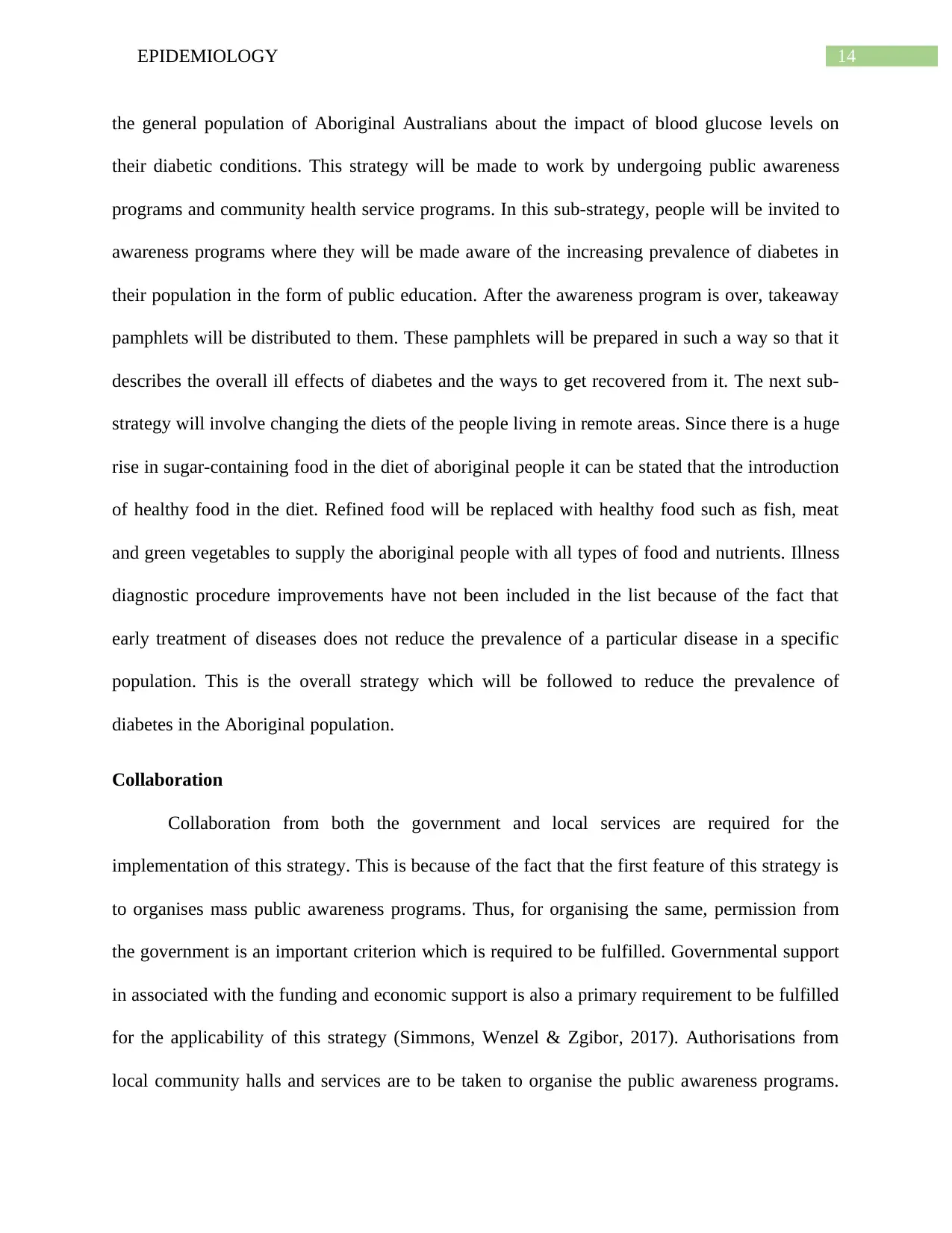
14EPIDEMIOLOGY
the general population of Aboriginal Australians about the impact of blood glucose levels on
their diabetic conditions. This strategy will be made to work by undergoing public awareness
programs and community health service programs. In this sub-strategy, people will be invited to
awareness programs where they will be made aware of the increasing prevalence of diabetes in
their population in the form of public education. After the awareness program is over, takeaway
pamphlets will be distributed to them. These pamphlets will be prepared in such a way so that it
describes the overall ill effects of diabetes and the ways to get recovered from it. The next sub-
strategy will involve changing the diets of the people living in remote areas. Since there is a huge
rise in sugar-containing food in the diet of aboriginal people it can be stated that the introduction
of healthy food in the diet. Refined food will be replaced with healthy food such as fish, meat
and green vegetables to supply the aboriginal people with all types of food and nutrients. Illness
diagnostic procedure improvements have not been included in the list because of the fact that
early treatment of diseases does not reduce the prevalence of a particular disease in a specific
population. This is the overall strategy which will be followed to reduce the prevalence of
diabetes in the Aboriginal population.
Collaboration
Collaboration from both the government and local services are required for the
implementation of this strategy. This is because of the fact that the first feature of this strategy is
to organises mass public awareness programs. Thus, for organising the same, permission from
the government is an important criterion which is required to be fulfilled. Governmental support
in associated with the funding and economic support is also a primary requirement to be fulfilled
for the applicability of this strategy (Simmons, Wenzel & Zgibor, 2017). Authorisations from
local community halls and services are to be taken to organise the public awareness programs.
the general population of Aboriginal Australians about the impact of blood glucose levels on
their diabetic conditions. This strategy will be made to work by undergoing public awareness
programs and community health service programs. In this sub-strategy, people will be invited to
awareness programs where they will be made aware of the increasing prevalence of diabetes in
their population in the form of public education. After the awareness program is over, takeaway
pamphlets will be distributed to them. These pamphlets will be prepared in such a way so that it
describes the overall ill effects of diabetes and the ways to get recovered from it. The next sub-
strategy will involve changing the diets of the people living in remote areas. Since there is a huge
rise in sugar-containing food in the diet of aboriginal people it can be stated that the introduction
of healthy food in the diet. Refined food will be replaced with healthy food such as fish, meat
and green vegetables to supply the aboriginal people with all types of food and nutrients. Illness
diagnostic procedure improvements have not been included in the list because of the fact that
early treatment of diseases does not reduce the prevalence of a particular disease in a specific
population. This is the overall strategy which will be followed to reduce the prevalence of
diabetes in the Aboriginal population.
Collaboration
Collaboration from both the government and local services are required for the
implementation of this strategy. This is because of the fact that the first feature of this strategy is
to organises mass public awareness programs. Thus, for organising the same, permission from
the government is an important criterion which is required to be fulfilled. Governmental support
in associated with the funding and economic support is also a primary requirement to be fulfilled
for the applicability of this strategy (Simmons, Wenzel & Zgibor, 2017). Authorisations from
local community halls and services are to be taken to organise the public awareness programs.
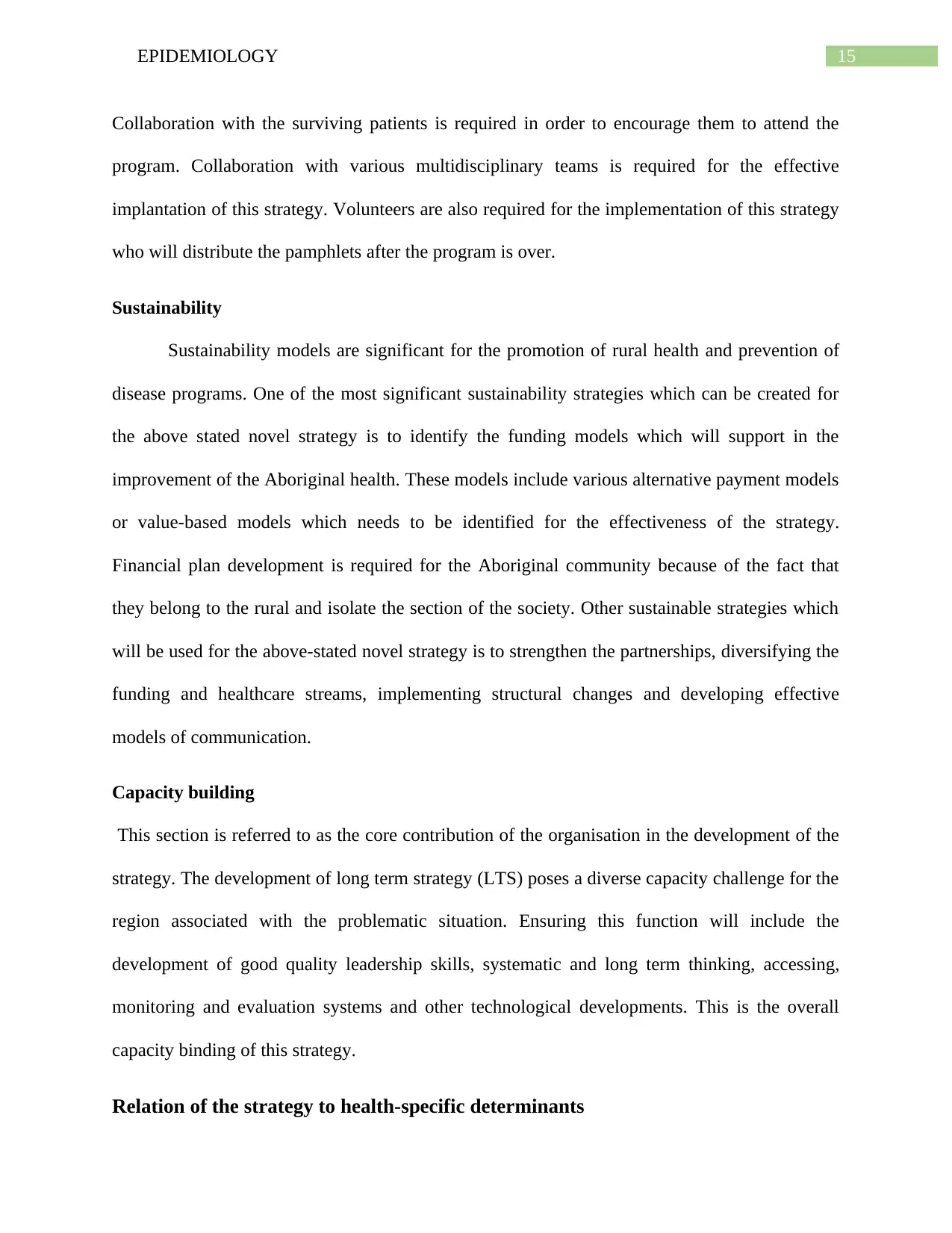
15EPIDEMIOLOGY
Collaboration with the surviving patients is required in order to encourage them to attend the
program. Collaboration with various multidisciplinary teams is required for the effective
implantation of this strategy. Volunteers are also required for the implementation of this strategy
who will distribute the pamphlets after the program is over.
Sustainability
Sustainability models are significant for the promotion of rural health and prevention of
disease programs. One of the most significant sustainability strategies which can be created for
the above stated novel strategy is to identify the funding models which will support in the
improvement of the Aboriginal health. These models include various alternative payment models
or value-based models which needs to be identified for the effectiveness of the strategy.
Financial plan development is required for the Aboriginal community because of the fact that
they belong to the rural and isolate the section of the society. Other sustainable strategies which
will be used for the above-stated novel strategy is to strengthen the partnerships, diversifying the
funding and healthcare streams, implementing structural changes and developing effective
models of communication.
Capacity building
This section is referred to as the core contribution of the organisation in the development of the
strategy. The development of long term strategy (LTS) poses a diverse capacity challenge for the
region associated with the problematic situation. Ensuring this function will include the
development of good quality leadership skills, systematic and long term thinking, accessing,
monitoring and evaluation systems and other technological developments. This is the overall
capacity binding of this strategy.
Relation of the strategy to health-specific determinants
Collaboration with the surviving patients is required in order to encourage them to attend the
program. Collaboration with various multidisciplinary teams is required for the effective
implantation of this strategy. Volunteers are also required for the implementation of this strategy
who will distribute the pamphlets after the program is over.
Sustainability
Sustainability models are significant for the promotion of rural health and prevention of
disease programs. One of the most significant sustainability strategies which can be created for
the above stated novel strategy is to identify the funding models which will support in the
improvement of the Aboriginal health. These models include various alternative payment models
or value-based models which needs to be identified for the effectiveness of the strategy.
Financial plan development is required for the Aboriginal community because of the fact that
they belong to the rural and isolate the section of the society. Other sustainable strategies which
will be used for the above-stated novel strategy is to strengthen the partnerships, diversifying the
funding and healthcare streams, implementing structural changes and developing effective
models of communication.
Capacity building
This section is referred to as the core contribution of the organisation in the development of the
strategy. The development of long term strategy (LTS) poses a diverse capacity challenge for the
region associated with the problematic situation. Ensuring this function will include the
development of good quality leadership skills, systematic and long term thinking, accessing,
monitoring and evaluation systems and other technological developments. This is the overall
capacity binding of this strategy.
Relation of the strategy to health-specific determinants
Secure Best Marks with AI Grader
Need help grading? Try our AI Grader for instant feedback on your assignments.
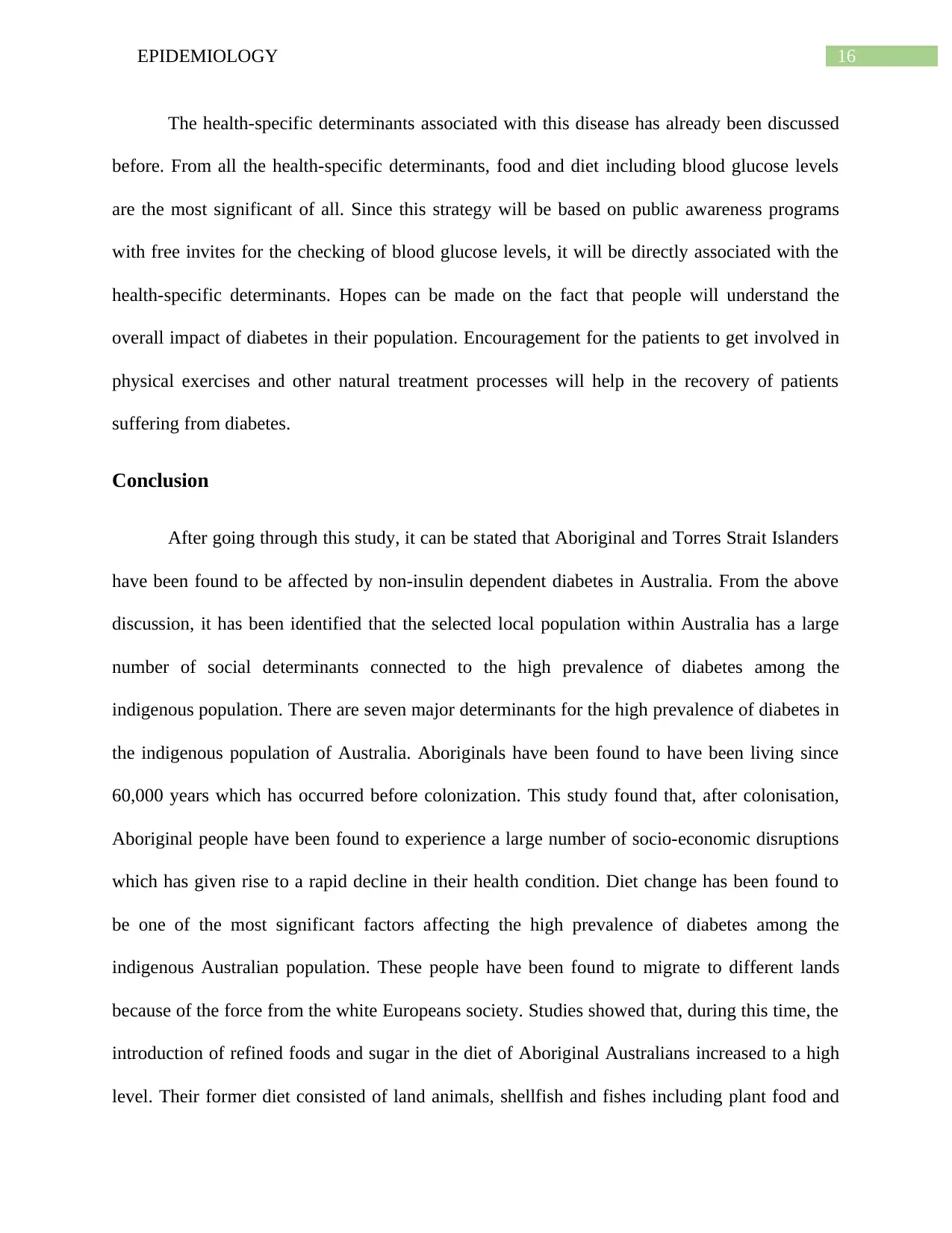
16EPIDEMIOLOGY
The health-specific determinants associated with this disease has already been discussed
before. From all the health-specific determinants, food and diet including blood glucose levels
are the most significant of all. Since this strategy will be based on public awareness programs
with free invites for the checking of blood glucose levels, it will be directly associated with the
health-specific determinants. Hopes can be made on the fact that people will understand the
overall impact of diabetes in their population. Encouragement for the patients to get involved in
physical exercises and other natural treatment processes will help in the recovery of patients
suffering from diabetes.
Conclusion
After going through this study, it can be stated that Aboriginal and Torres Strait Islanders
have been found to be affected by non-insulin dependent diabetes in Australia. From the above
discussion, it has been identified that the selected local population within Australia has a large
number of social determinants connected to the high prevalence of diabetes among the
indigenous population. There are seven major determinants for the high prevalence of diabetes in
the indigenous population of Australia. Aboriginals have been found to have been living since
60,000 years which has occurred before colonization. This study found that, after colonisation,
Aboriginal people have been found to experience a large number of socio-economic disruptions
which has given rise to a rapid decline in their health condition. Diet change has been found to
be one of the most significant factors affecting the high prevalence of diabetes among the
indigenous Australian population. These people have been found to migrate to different lands
because of the force from the white Europeans society. Studies showed that, during this time, the
introduction of refined foods and sugar in the diet of Aboriginal Australians increased to a high
level. Their former diet consisted of land animals, shellfish and fishes including plant food and
The health-specific determinants associated with this disease has already been discussed
before. From all the health-specific determinants, food and diet including blood glucose levels
are the most significant of all. Since this strategy will be based on public awareness programs
with free invites for the checking of blood glucose levels, it will be directly associated with the
health-specific determinants. Hopes can be made on the fact that people will understand the
overall impact of diabetes in their population. Encouragement for the patients to get involved in
physical exercises and other natural treatment processes will help in the recovery of patients
suffering from diabetes.
Conclusion
After going through this study, it can be stated that Aboriginal and Torres Strait Islanders
have been found to be affected by non-insulin dependent diabetes in Australia. From the above
discussion, it has been identified that the selected local population within Australia has a large
number of social determinants connected to the high prevalence of diabetes among the
indigenous population. There are seven major determinants for the high prevalence of diabetes in
the indigenous population of Australia. Aboriginals have been found to have been living since
60,000 years which has occurred before colonization. This study found that, after colonisation,
Aboriginal people have been found to experience a large number of socio-economic disruptions
which has given rise to a rapid decline in their health condition. Diet change has been found to
be one of the most significant factors affecting the high prevalence of diabetes among the
indigenous Australian population. These people have been found to migrate to different lands
because of the force from the white Europeans society. Studies showed that, during this time, the
introduction of refined foods and sugar in the diet of Aboriginal Australians increased to a high
level. Their former diet consisted of land animals, shellfish and fishes including plant food and
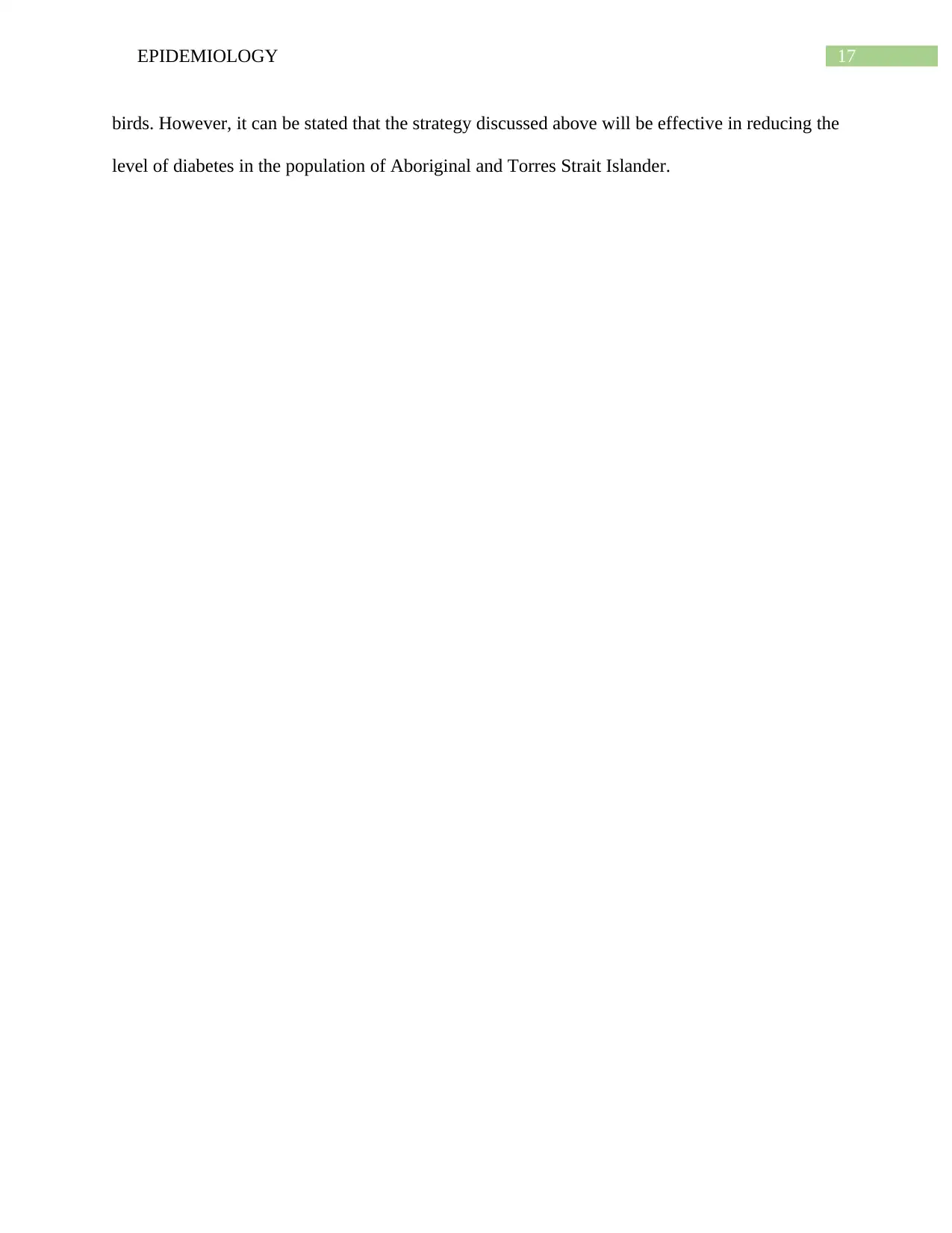
17EPIDEMIOLOGY
birds. However, it can be stated that the strategy discussed above will be effective in reducing the
level of diabetes in the population of Aboriginal and Torres Strait Islander.
birds. However, it can be stated that the strategy discussed above will be effective in reducing the
level of diabetes in the population of Aboriginal and Torres Strait Islander.
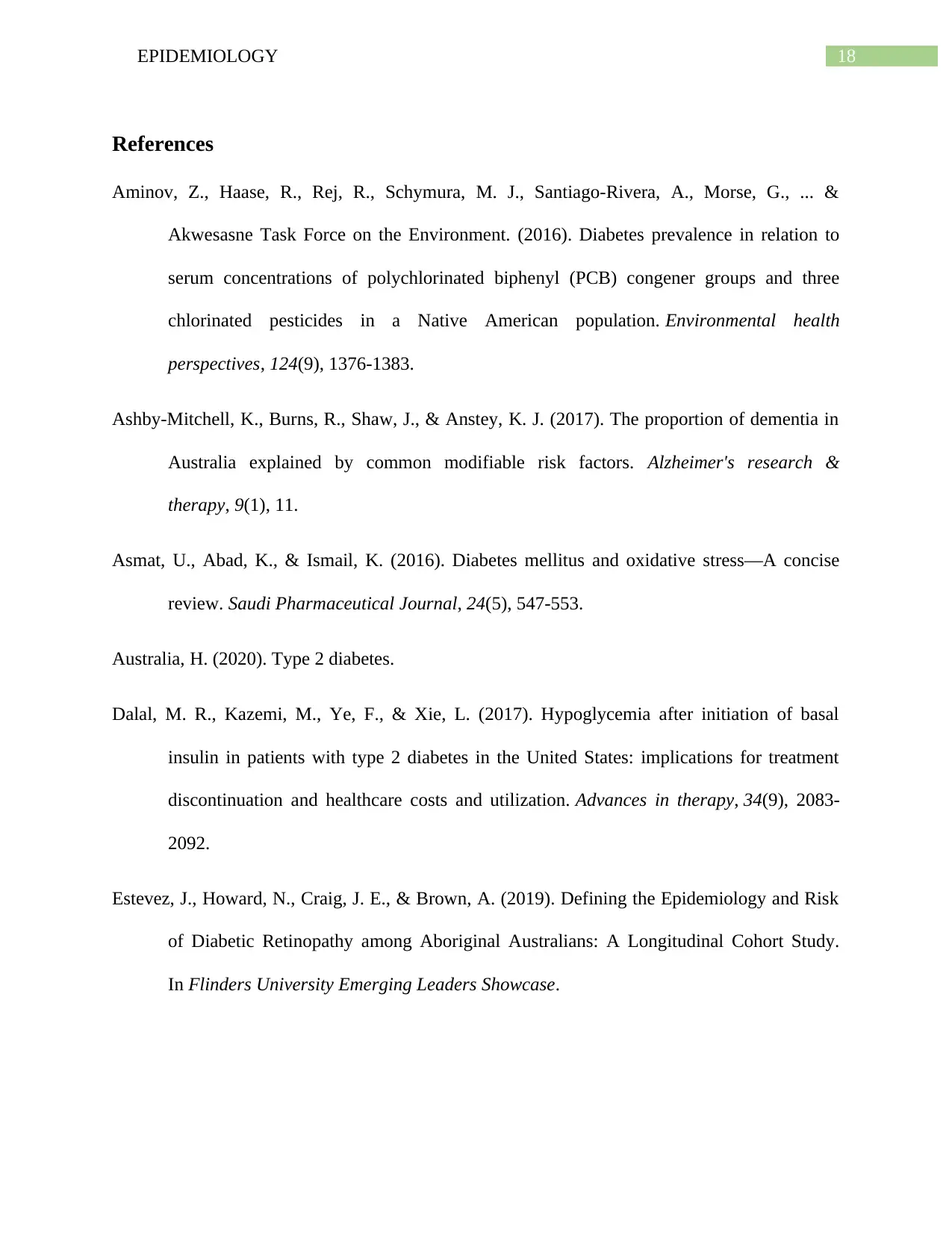
18EPIDEMIOLOGY
References
Aminov, Z., Haase, R., Rej, R., Schymura, M. J., Santiago-Rivera, A., Morse, G., ... &
Akwesasne Task Force on the Environment. (2016). Diabetes prevalence in relation to
serum concentrations of polychlorinated biphenyl (PCB) congener groups and three
chlorinated pesticides in a Native American population. Environmental health
perspectives, 124(9), 1376-1383.
Ashby-Mitchell, K., Burns, R., Shaw, J., & Anstey, K. J. (2017). The proportion of dementia in
Australia explained by common modifiable risk factors. Alzheimer's research &
therapy, 9(1), 11.
Asmat, U., Abad, K., & Ismail, K. (2016). Diabetes mellitus and oxidative stress—A concise
review. Saudi Pharmaceutical Journal, 24(5), 547-553.
Australia, H. (2020). Type 2 diabetes.
Dalal, M. R., Kazemi, M., Ye, F., & Xie, L. (2017). Hypoglycemia after initiation of basal
insulin in patients with type 2 diabetes in the United States: implications for treatment
discontinuation and healthcare costs and utilization. Advances in therapy, 34(9), 2083-
2092.
Estevez, J., Howard, N., Craig, J. E., & Brown, A. (2019). Defining the Epidemiology and Risk
of Diabetic Retinopathy among Aboriginal Australians: A Longitudinal Cohort Study.
In Flinders University Emerging Leaders Showcase.
References
Aminov, Z., Haase, R., Rej, R., Schymura, M. J., Santiago-Rivera, A., Morse, G., ... &
Akwesasne Task Force on the Environment. (2016). Diabetes prevalence in relation to
serum concentrations of polychlorinated biphenyl (PCB) congener groups and three
chlorinated pesticides in a Native American population. Environmental health
perspectives, 124(9), 1376-1383.
Ashby-Mitchell, K., Burns, R., Shaw, J., & Anstey, K. J. (2017). The proportion of dementia in
Australia explained by common modifiable risk factors. Alzheimer's research &
therapy, 9(1), 11.
Asmat, U., Abad, K., & Ismail, K. (2016). Diabetes mellitus and oxidative stress—A concise
review. Saudi Pharmaceutical Journal, 24(5), 547-553.
Australia, H. (2020). Type 2 diabetes.
Dalal, M. R., Kazemi, M., Ye, F., & Xie, L. (2017). Hypoglycemia after initiation of basal
insulin in patients with type 2 diabetes in the United States: implications for treatment
discontinuation and healthcare costs and utilization. Advances in therapy, 34(9), 2083-
2092.
Estevez, J., Howard, N., Craig, J. E., & Brown, A. (2019). Defining the Epidemiology and Risk
of Diabetic Retinopathy among Aboriginal Australians: A Longitudinal Cohort Study.
In Flinders University Emerging Leaders Showcase.
Paraphrase This Document
Need a fresh take? Get an instant paraphrase of this document with our AI Paraphraser
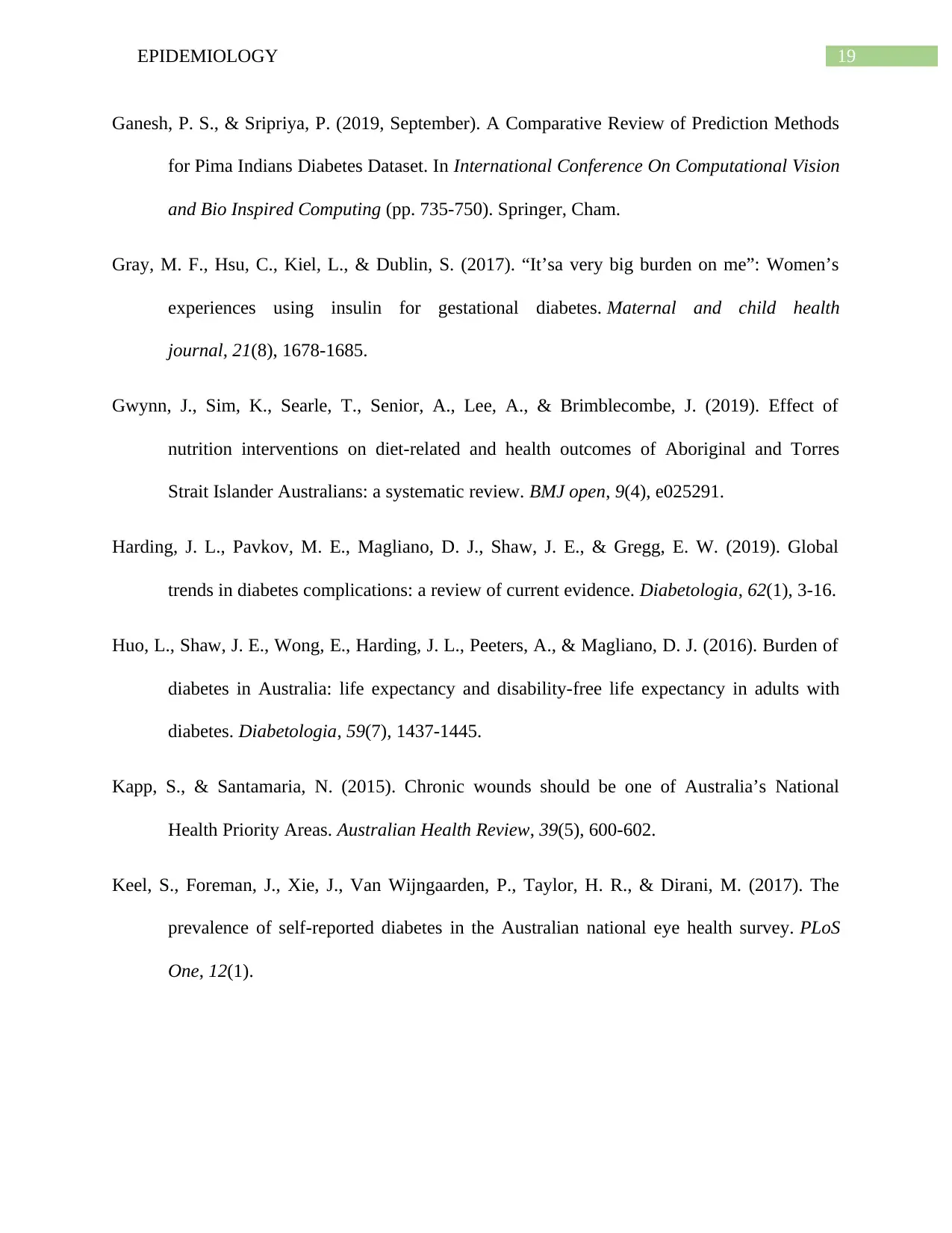
19EPIDEMIOLOGY
Ganesh, P. S., & Sripriya, P. (2019, September). A Comparative Review of Prediction Methods
for Pima Indians Diabetes Dataset. In International Conference On Computational Vision
and Bio Inspired Computing (pp. 735-750). Springer, Cham.
Gray, M. F., Hsu, C., Kiel, L., & Dublin, S. (2017). “It’sa very big burden on me”: Women’s
experiences using insulin for gestational diabetes. Maternal and child health
journal, 21(8), 1678-1685.
Gwynn, J., Sim, K., Searle, T., Senior, A., Lee, A., & Brimblecombe, J. (2019). Effect of
nutrition interventions on diet-related and health outcomes of Aboriginal and Torres
Strait Islander Australians: a systematic review. BMJ open, 9(4), e025291.
Harding, J. L., Pavkov, M. E., Magliano, D. J., Shaw, J. E., & Gregg, E. W. (2019). Global
trends in diabetes complications: a review of current evidence. Diabetologia, 62(1), 3-16.
Huo, L., Shaw, J. E., Wong, E., Harding, J. L., Peeters, A., & Magliano, D. J. (2016). Burden of
diabetes in Australia: life expectancy and disability-free life expectancy in adults with
diabetes. Diabetologia, 59(7), 1437-1445.
Kapp, S., & Santamaria, N. (2015). Chronic wounds should be one of Australia’s National
Health Priority Areas. Australian Health Review, 39(5), 600-602.
Keel, S., Foreman, J., Xie, J., Van Wijngaarden, P., Taylor, H. R., & Dirani, M. (2017). The
prevalence of self-reported diabetes in the Australian national eye health survey. PLoS
One, 12(1).
Ganesh, P. S., & Sripriya, P. (2019, September). A Comparative Review of Prediction Methods
for Pima Indians Diabetes Dataset. In International Conference On Computational Vision
and Bio Inspired Computing (pp. 735-750). Springer, Cham.
Gray, M. F., Hsu, C., Kiel, L., & Dublin, S. (2017). “It’sa very big burden on me”: Women’s
experiences using insulin for gestational diabetes. Maternal and child health
journal, 21(8), 1678-1685.
Gwynn, J., Sim, K., Searle, T., Senior, A., Lee, A., & Brimblecombe, J. (2019). Effect of
nutrition interventions on diet-related and health outcomes of Aboriginal and Torres
Strait Islander Australians: a systematic review. BMJ open, 9(4), e025291.
Harding, J. L., Pavkov, M. E., Magliano, D. J., Shaw, J. E., & Gregg, E. W. (2019). Global
trends in diabetes complications: a review of current evidence. Diabetologia, 62(1), 3-16.
Huo, L., Shaw, J. E., Wong, E., Harding, J. L., Peeters, A., & Magliano, D. J. (2016). Burden of
diabetes in Australia: life expectancy and disability-free life expectancy in adults with
diabetes. Diabetologia, 59(7), 1437-1445.
Kapp, S., & Santamaria, N. (2015). Chronic wounds should be one of Australia’s National
Health Priority Areas. Australian Health Review, 39(5), 600-602.
Keel, S., Foreman, J., Xie, J., Van Wijngaarden, P., Taylor, H. R., & Dirani, M. (2017). The
prevalence of self-reported diabetes in the Australian national eye health survey. PLoS
One, 12(1).
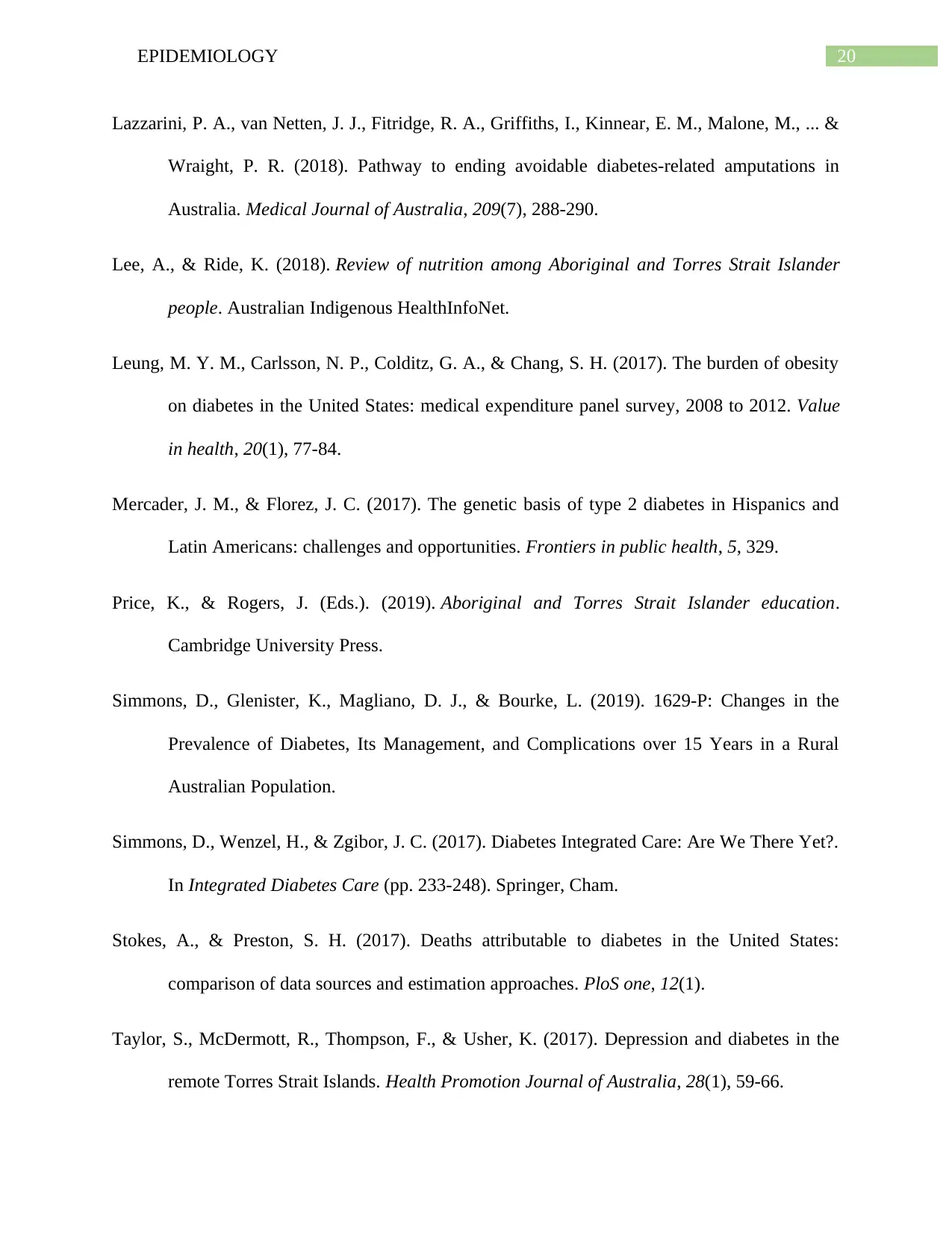
20EPIDEMIOLOGY
Lazzarini, P. A., van Netten, J. J., Fitridge, R. A., Griffiths, I., Kinnear, E. M., Malone, M., ... &
Wraight, P. R. (2018). Pathway to ending avoidable diabetes‐related amputations in
Australia. Medical Journal of Australia, 209(7), 288-290.
Lee, A., & Ride, K. (2018). Review of nutrition among Aboriginal and Torres Strait Islander
people. Australian Indigenous HealthInfoNet.
Leung, M. Y. M., Carlsson, N. P., Colditz, G. A., & Chang, S. H. (2017). The burden of obesity
on diabetes in the United States: medical expenditure panel survey, 2008 to 2012. Value
in health, 20(1), 77-84.
Mercader, J. M., & Florez, J. C. (2017). The genetic basis of type 2 diabetes in Hispanics and
Latin Americans: challenges and opportunities. Frontiers in public health, 5, 329.
Price, K., & Rogers, J. (Eds.). (2019). Aboriginal and Torres Strait Islander education.
Cambridge University Press.
Simmons, D., Glenister, K., Magliano, D. J., & Bourke, L. (2019). 1629-P: Changes in the
Prevalence of Diabetes, Its Management, and Complications over 15 Years in a Rural
Australian Population.
Simmons, D., Wenzel, H., & Zgibor, J. C. (2017). Diabetes Integrated Care: Are We There Yet?.
In Integrated Diabetes Care (pp. 233-248). Springer, Cham.
Stokes, A., & Preston, S. H. (2017). Deaths attributable to diabetes in the United States:
comparison of data sources and estimation approaches. PloS one, 12(1).
Taylor, S., McDermott, R., Thompson, F., & Usher, K. (2017). Depression and diabetes in the
remote Torres Strait Islands. Health Promotion Journal of Australia, 28(1), 59-66.
Lazzarini, P. A., van Netten, J. J., Fitridge, R. A., Griffiths, I., Kinnear, E. M., Malone, M., ... &
Wraight, P. R. (2018). Pathway to ending avoidable diabetes‐related amputations in
Australia. Medical Journal of Australia, 209(7), 288-290.
Lee, A., & Ride, K. (2018). Review of nutrition among Aboriginal and Torres Strait Islander
people. Australian Indigenous HealthInfoNet.
Leung, M. Y. M., Carlsson, N. P., Colditz, G. A., & Chang, S. H. (2017). The burden of obesity
on diabetes in the United States: medical expenditure panel survey, 2008 to 2012. Value
in health, 20(1), 77-84.
Mercader, J. M., & Florez, J. C. (2017). The genetic basis of type 2 diabetes in Hispanics and
Latin Americans: challenges and opportunities. Frontiers in public health, 5, 329.
Price, K., & Rogers, J. (Eds.). (2019). Aboriginal and Torres Strait Islander education.
Cambridge University Press.
Simmons, D., Glenister, K., Magliano, D. J., & Bourke, L. (2019). 1629-P: Changes in the
Prevalence of Diabetes, Its Management, and Complications over 15 Years in a Rural
Australian Population.
Simmons, D., Wenzel, H., & Zgibor, J. C. (2017). Diabetes Integrated Care: Are We There Yet?.
In Integrated Diabetes Care (pp. 233-248). Springer, Cham.
Stokes, A., & Preston, S. H. (2017). Deaths attributable to diabetes in the United States:
comparison of data sources and estimation approaches. PloS one, 12(1).
Taylor, S., McDermott, R., Thompson, F., & Usher, K. (2017). Depression and diabetes in the
remote Torres Strait Islands. Health Promotion Journal of Australia, 28(1), 59-66.
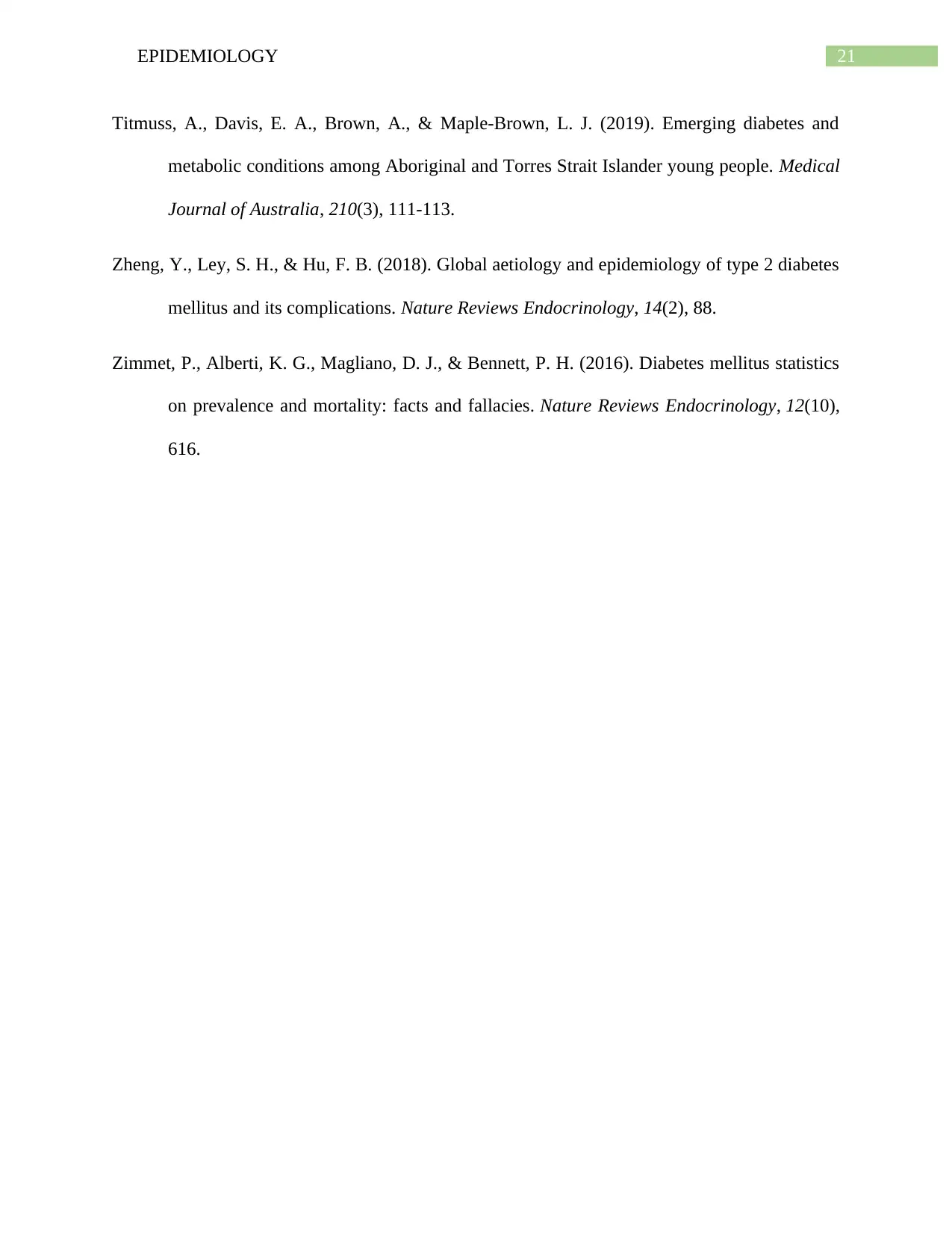
21EPIDEMIOLOGY
Titmuss, A., Davis, E. A., Brown, A., & Maple‐Brown, L. J. (2019). Emerging diabetes and
metabolic conditions among Aboriginal and Torres Strait Islander young people. Medical
Journal of Australia, 210(3), 111-113.
Zheng, Y., Ley, S. H., & Hu, F. B. (2018). Global aetiology and epidemiology of type 2 diabetes
mellitus and its complications. Nature Reviews Endocrinology, 14(2), 88.
Zimmet, P., Alberti, K. G., Magliano, D. J., & Bennett, P. H. (2016). Diabetes mellitus statistics
on prevalence and mortality: facts and fallacies. Nature Reviews Endocrinology, 12(10),
616.
Titmuss, A., Davis, E. A., Brown, A., & Maple‐Brown, L. J. (2019). Emerging diabetes and
metabolic conditions among Aboriginal and Torres Strait Islander young people. Medical
Journal of Australia, 210(3), 111-113.
Zheng, Y., Ley, S. H., & Hu, F. B. (2018). Global aetiology and epidemiology of type 2 diabetes
mellitus and its complications. Nature Reviews Endocrinology, 14(2), 88.
Zimmet, P., Alberti, K. G., Magliano, D. J., & Bennett, P. H. (2016). Diabetes mellitus statistics
on prevalence and mortality: facts and fallacies. Nature Reviews Endocrinology, 12(10),
616.
1 out of 22
Related Documents
Your All-in-One AI-Powered Toolkit for Academic Success.
+13062052269
info@desklib.com
Available 24*7 on WhatsApp / Email
![[object Object]](/_next/static/media/star-bottom.7253800d.svg)
Unlock your academic potential
© 2024 | Zucol Services PVT LTD | All rights reserved.





